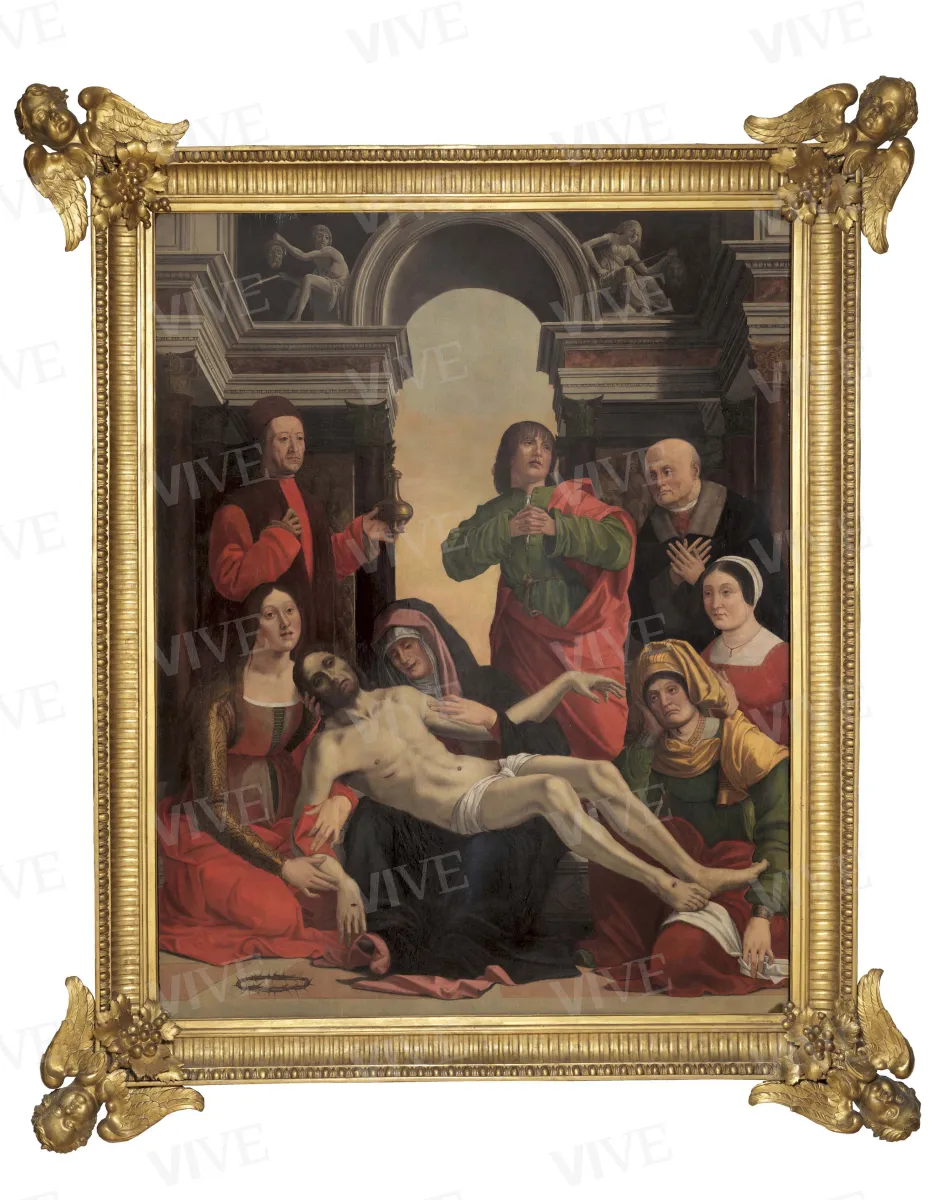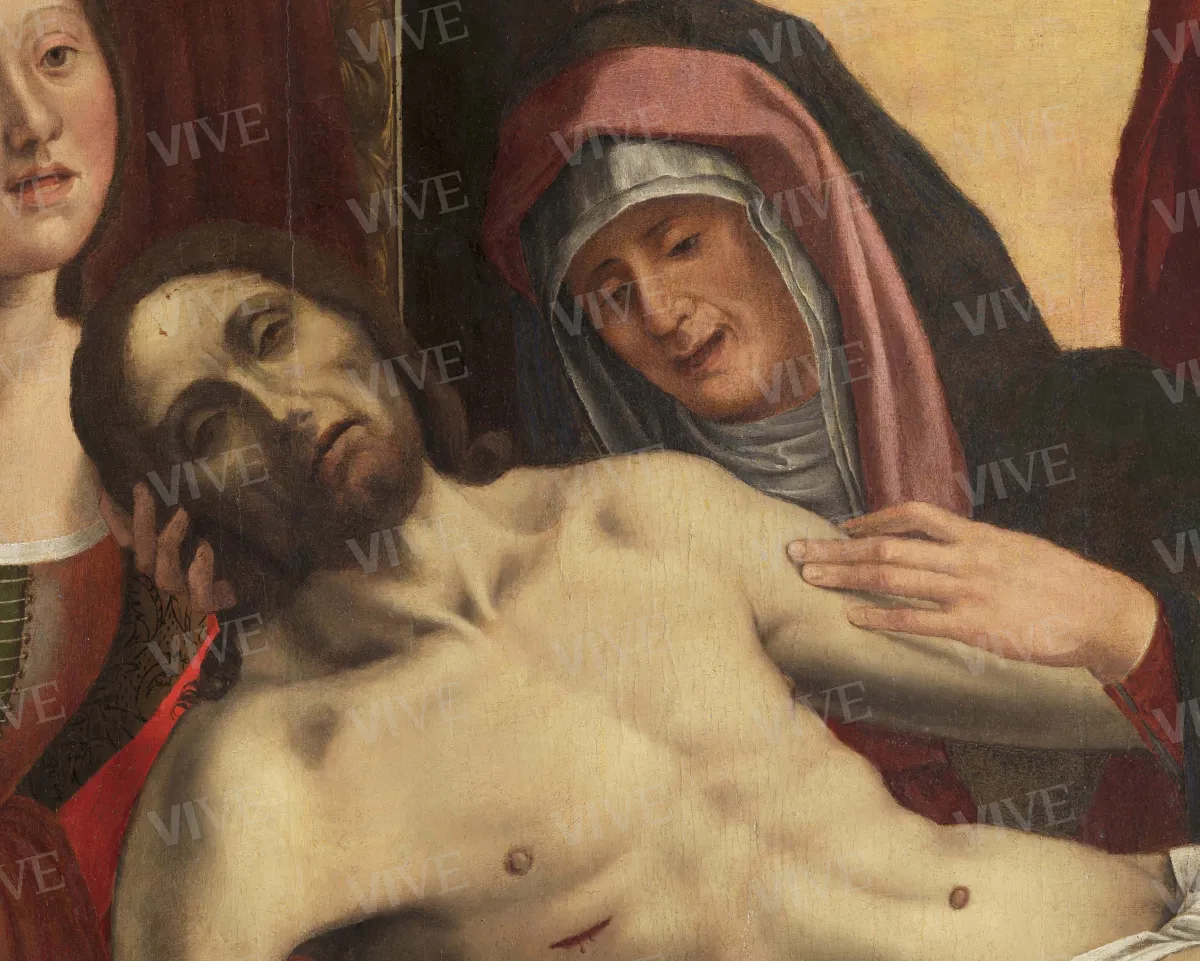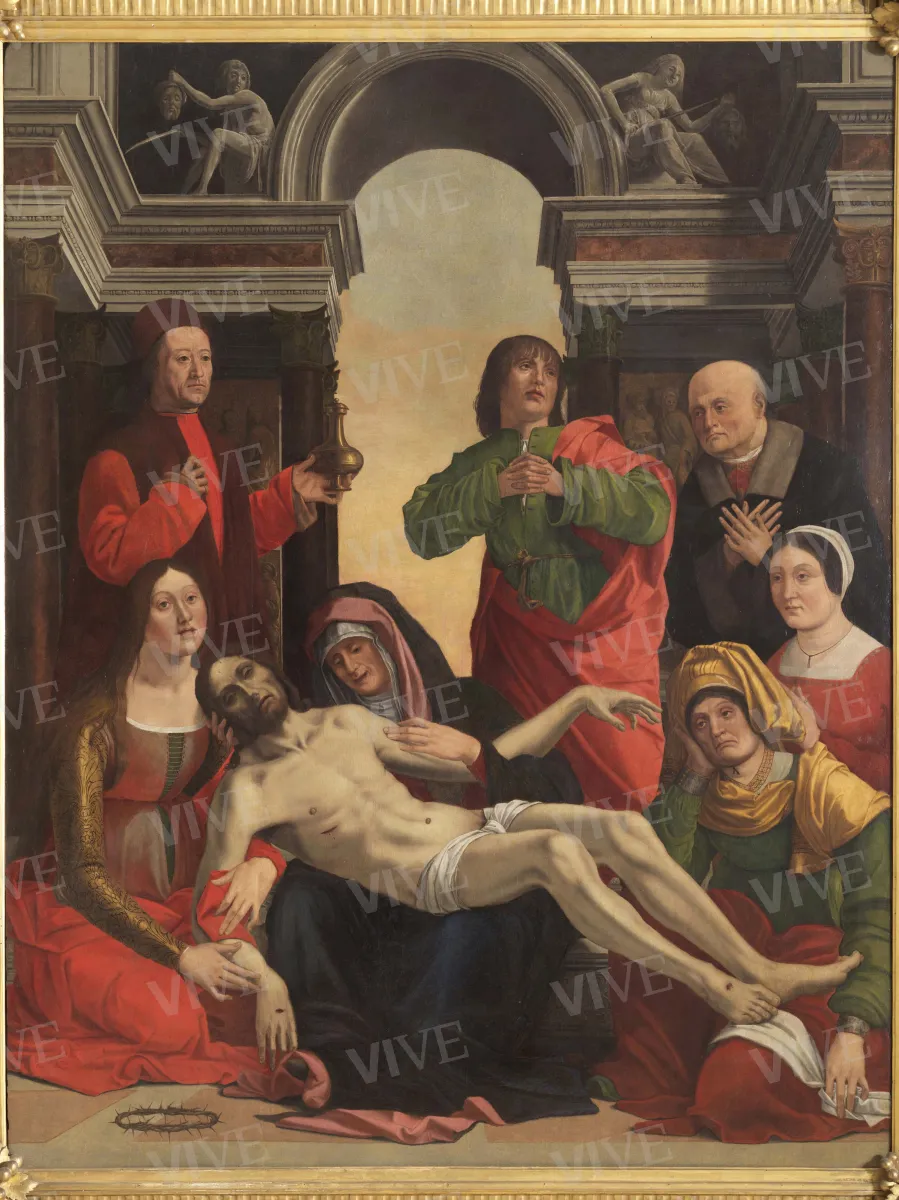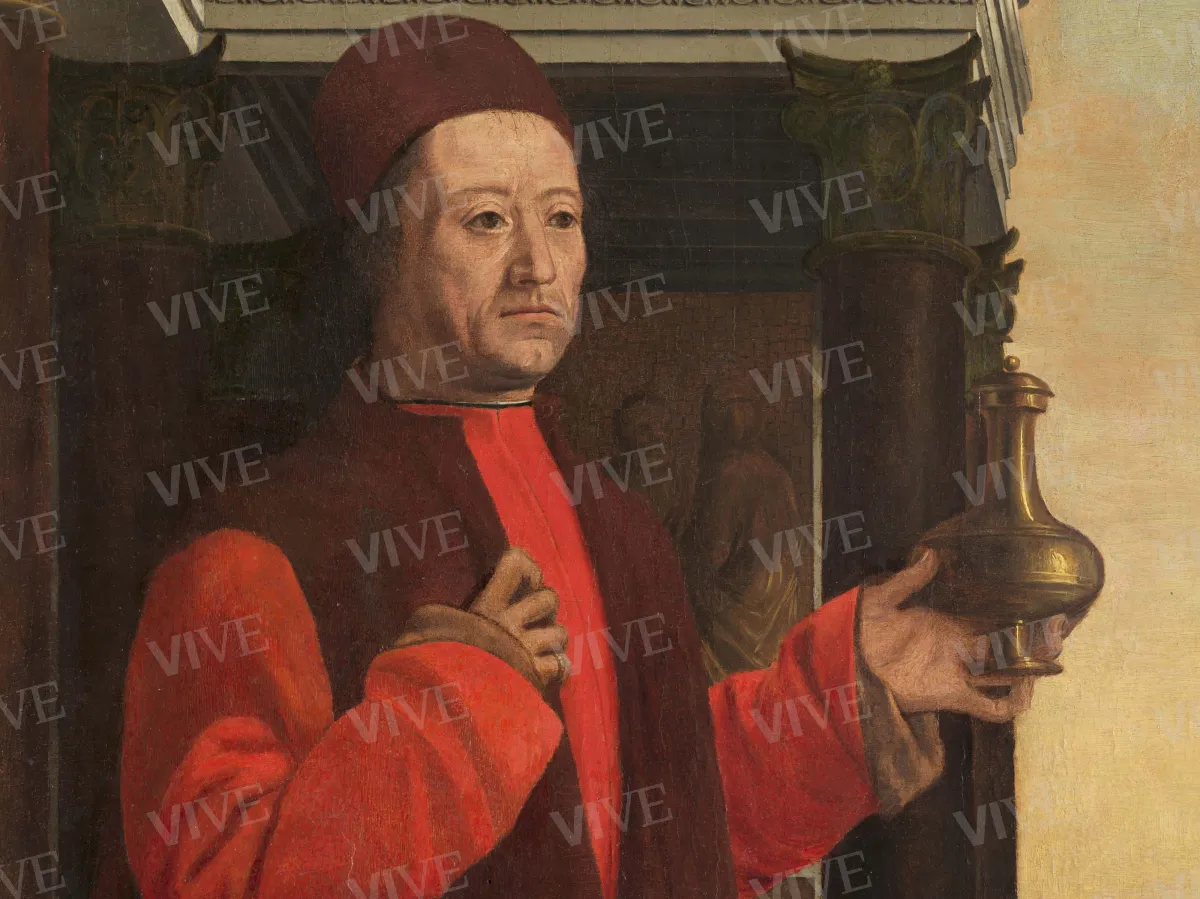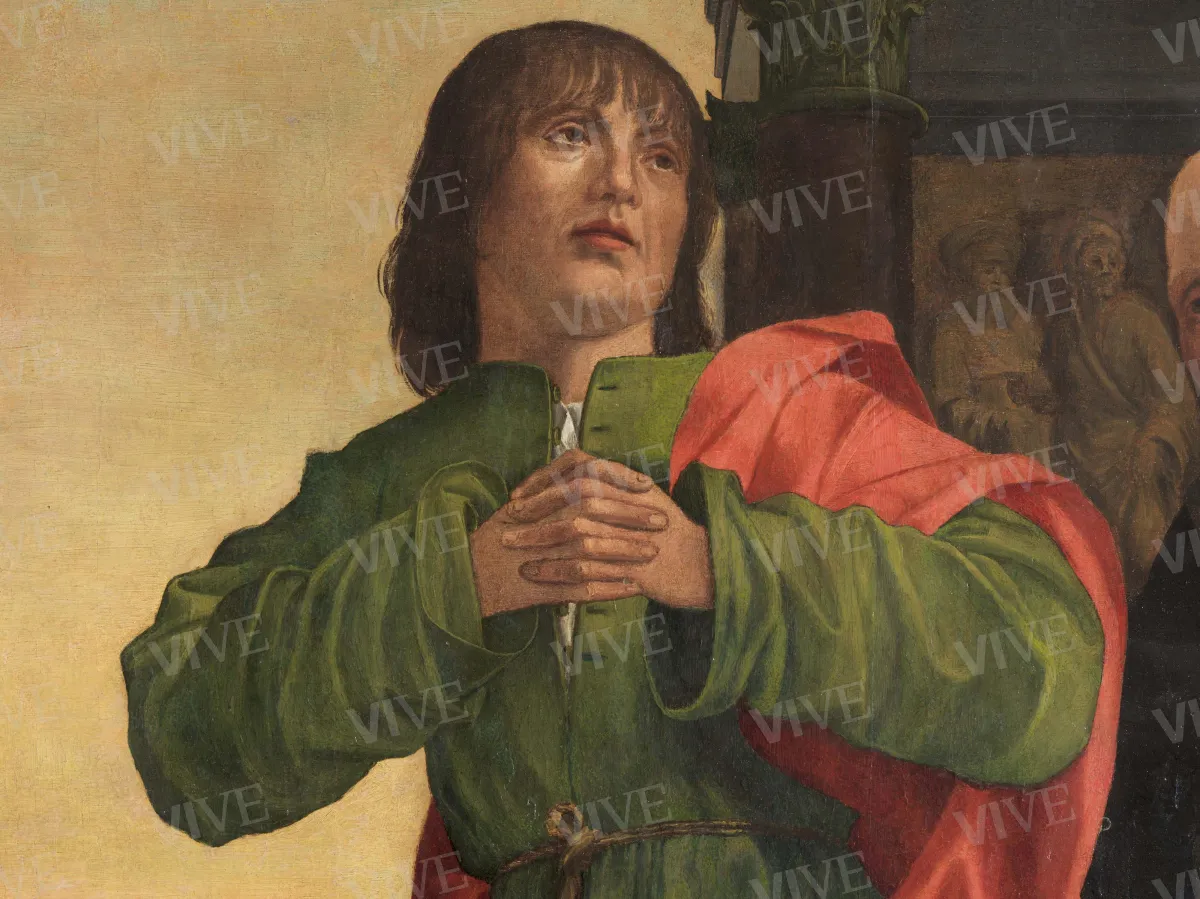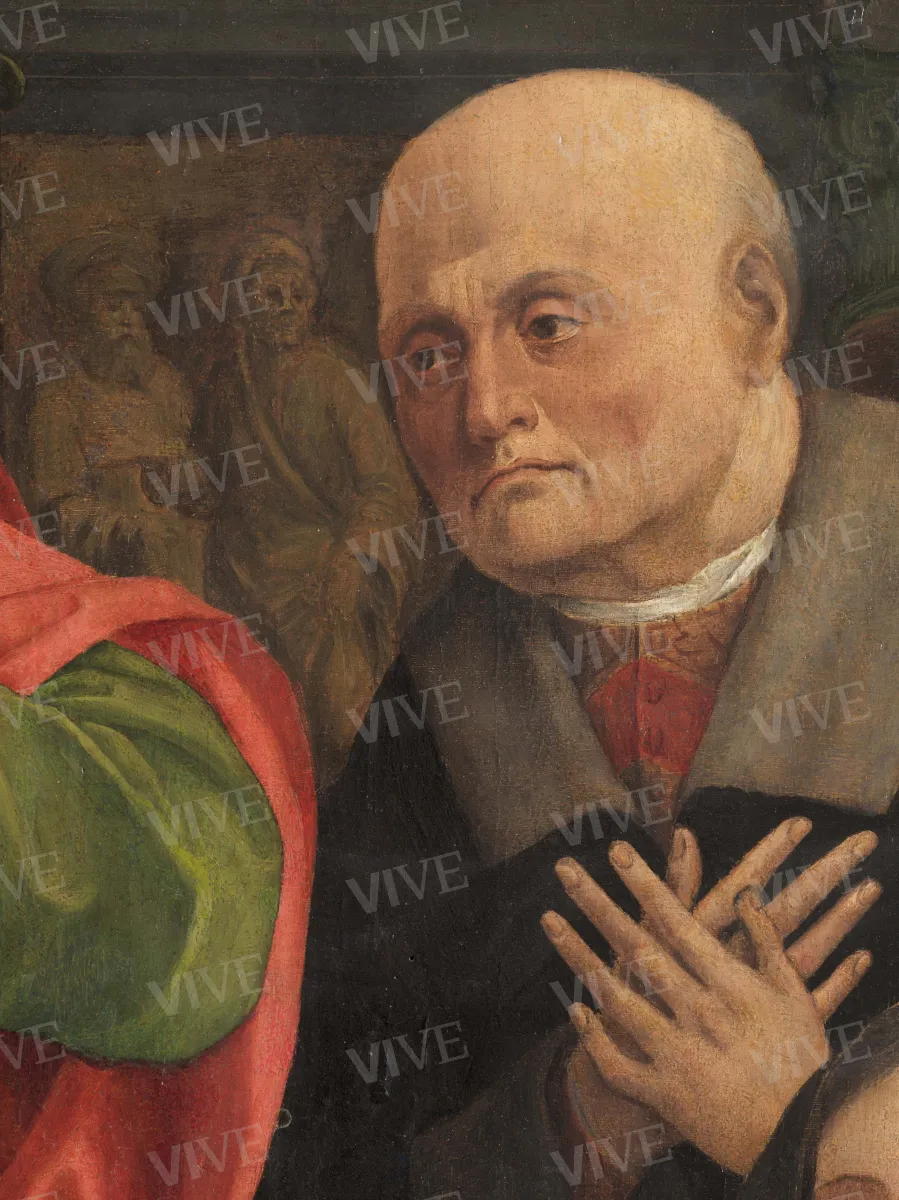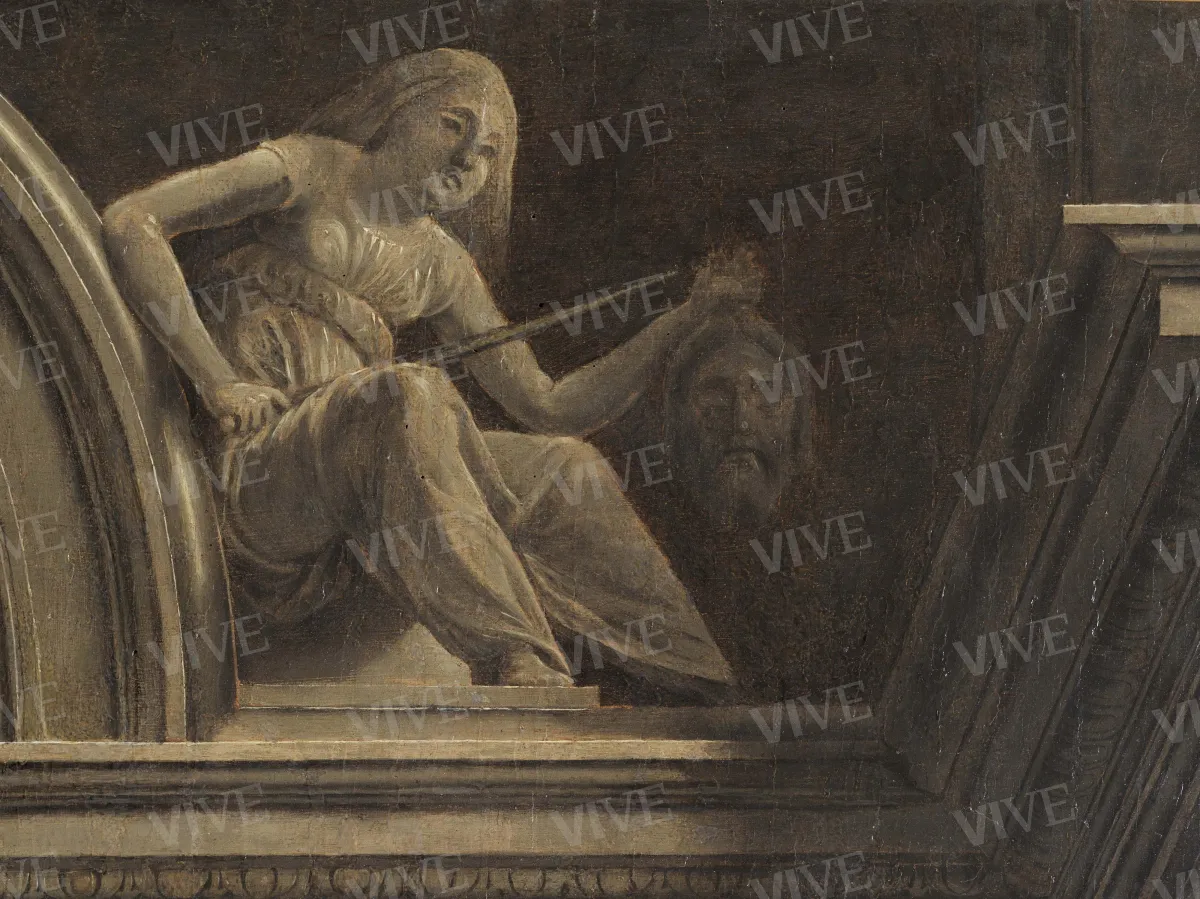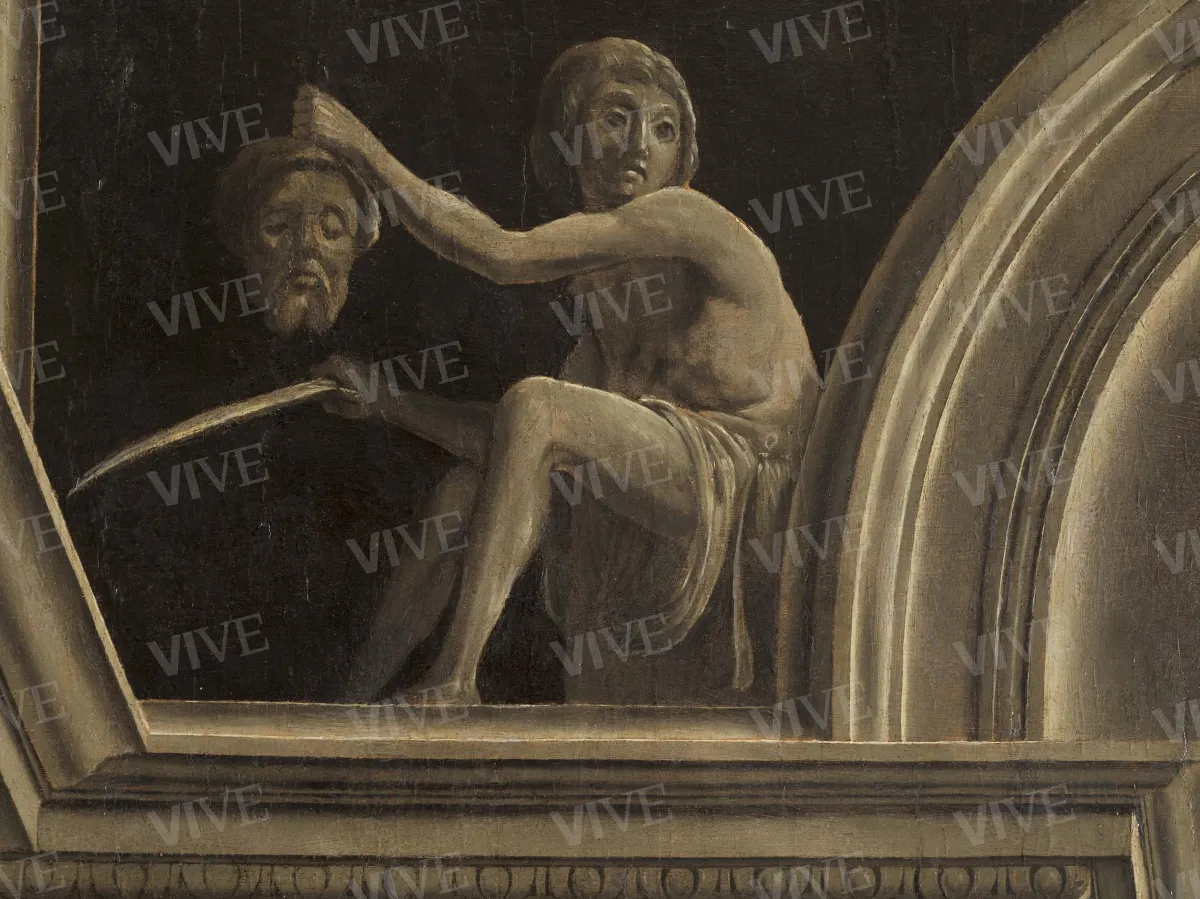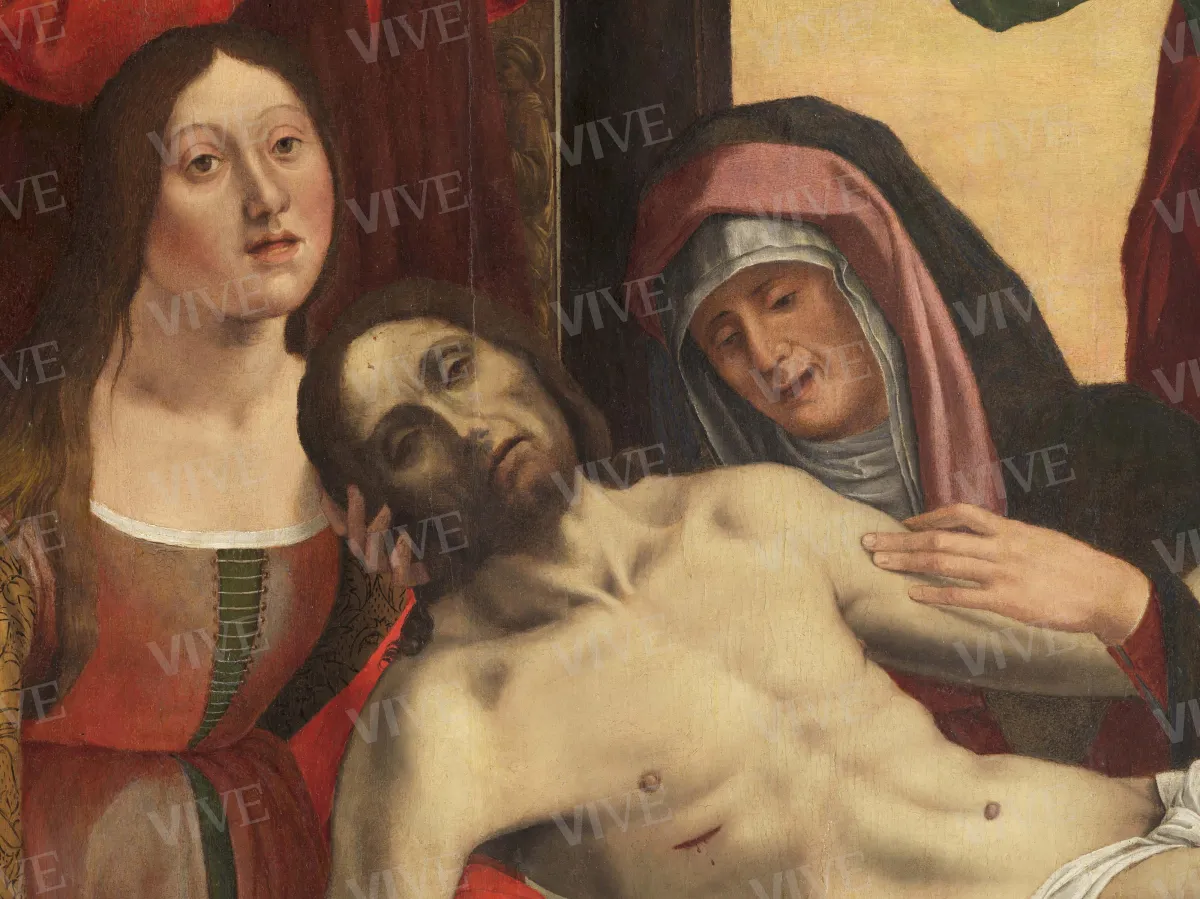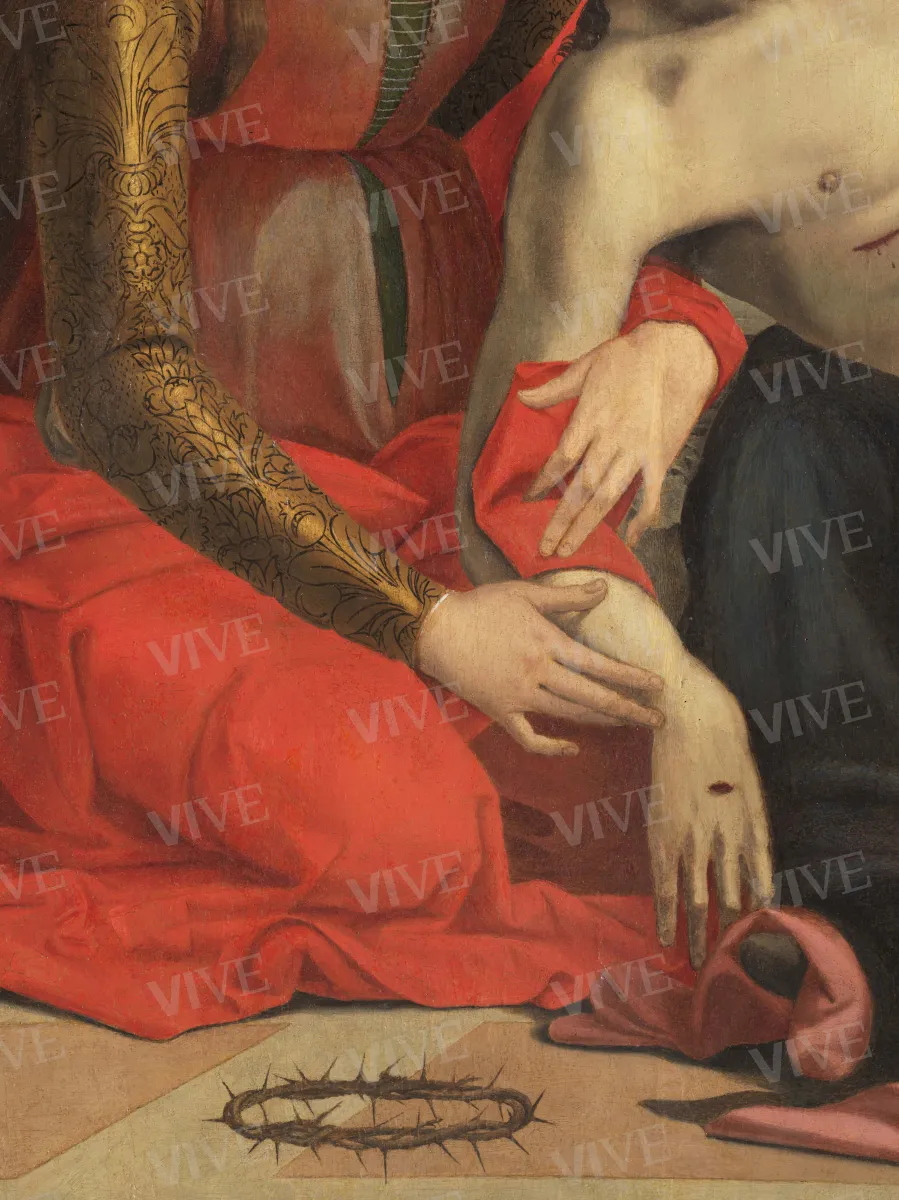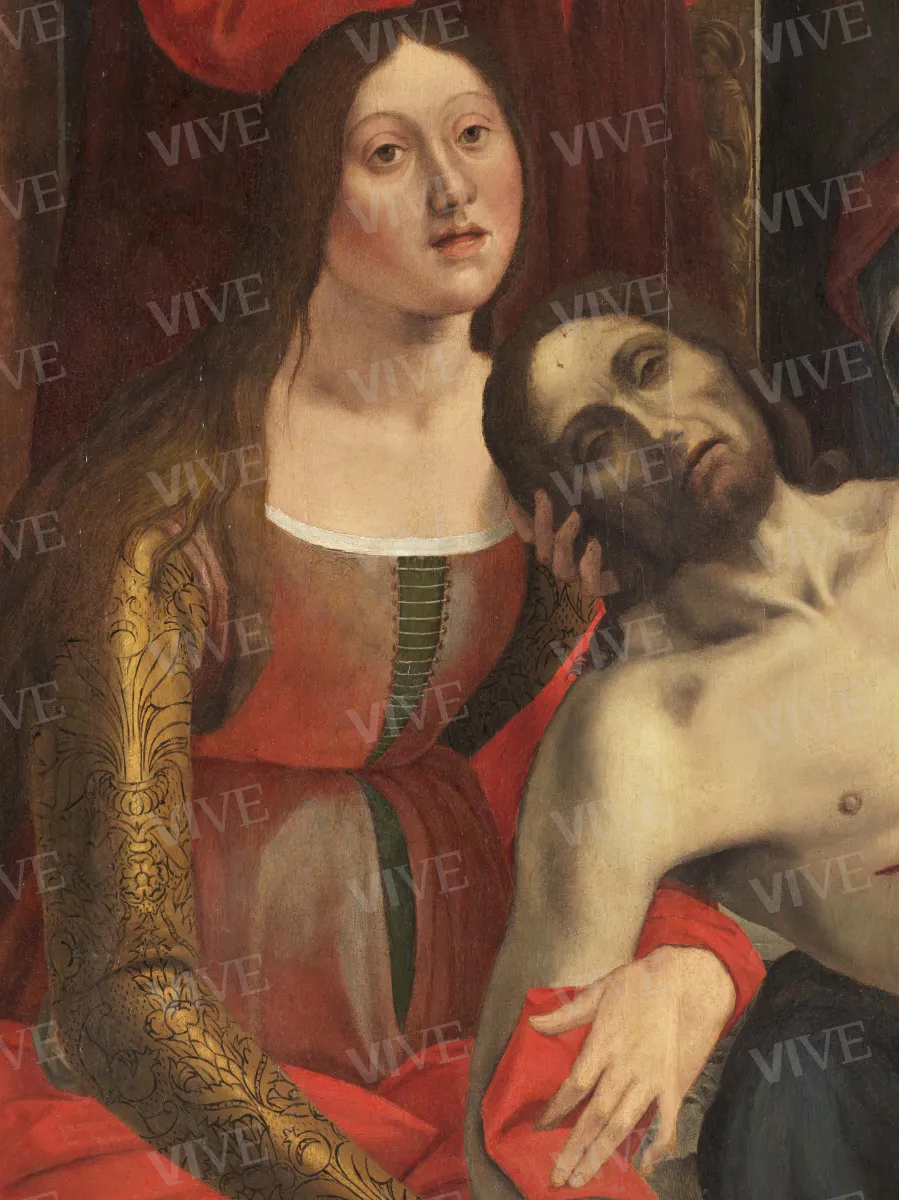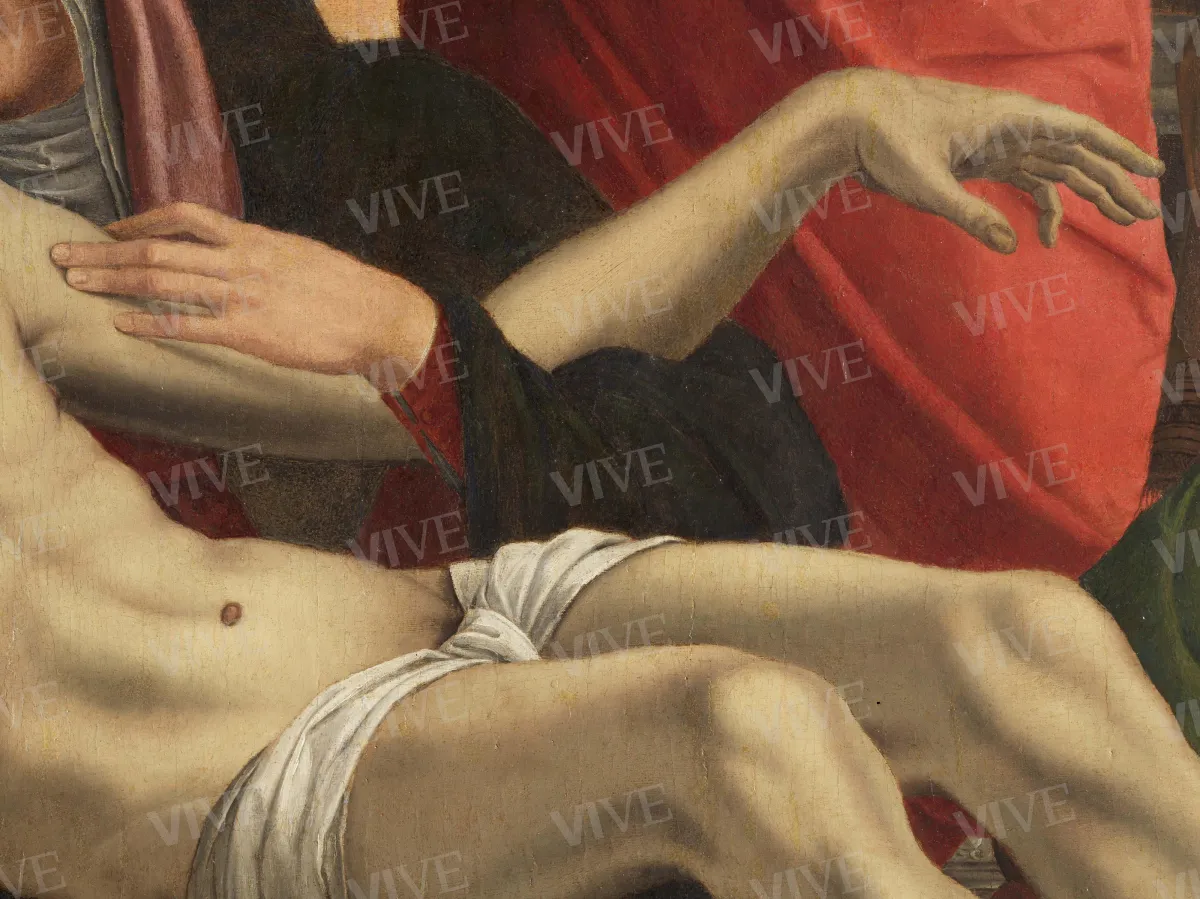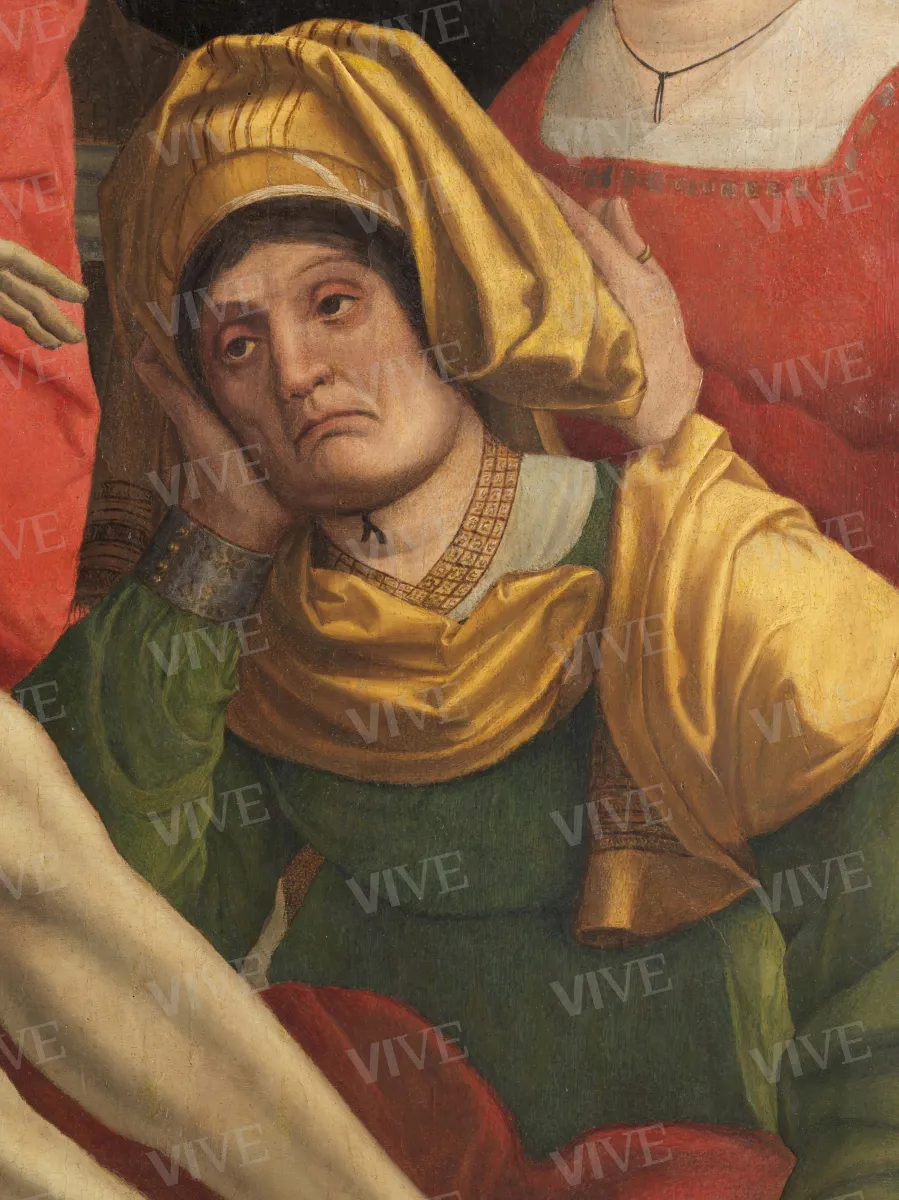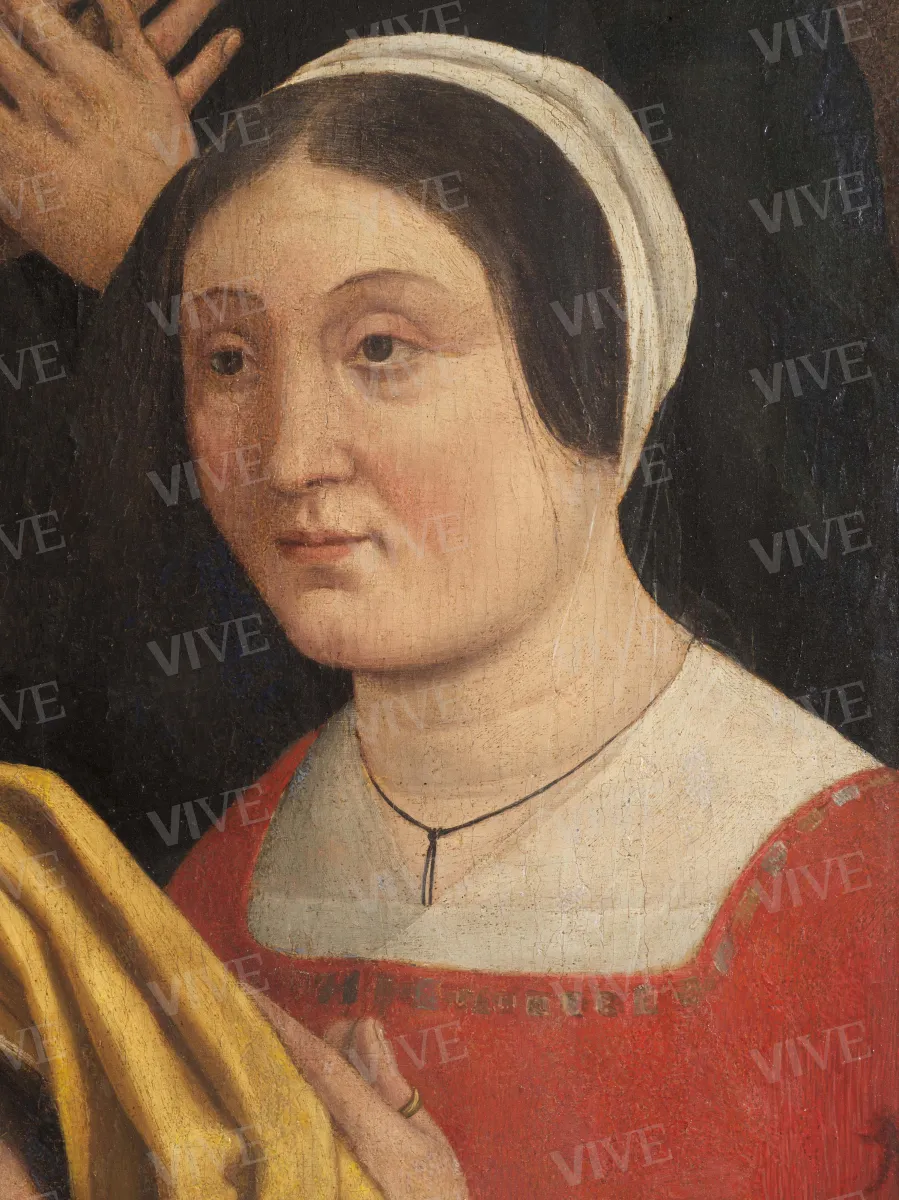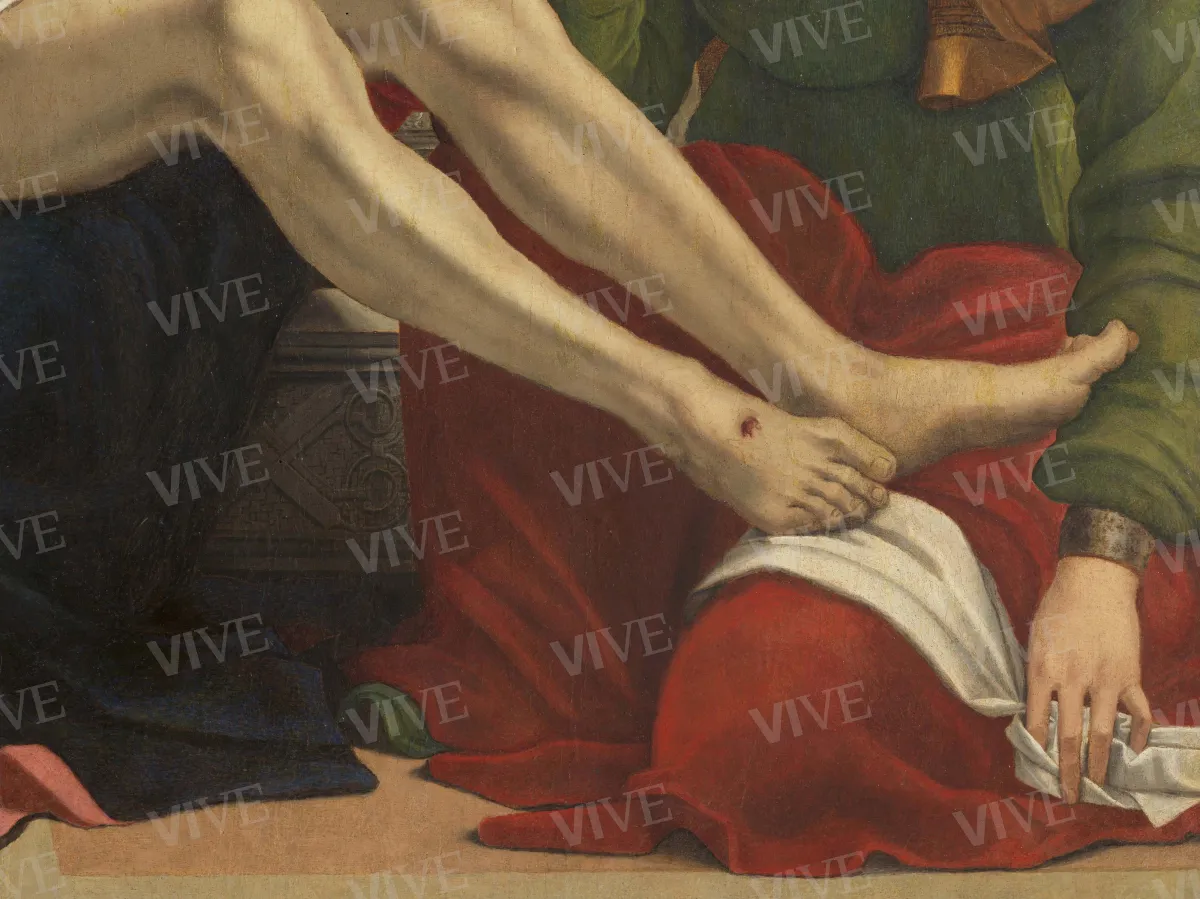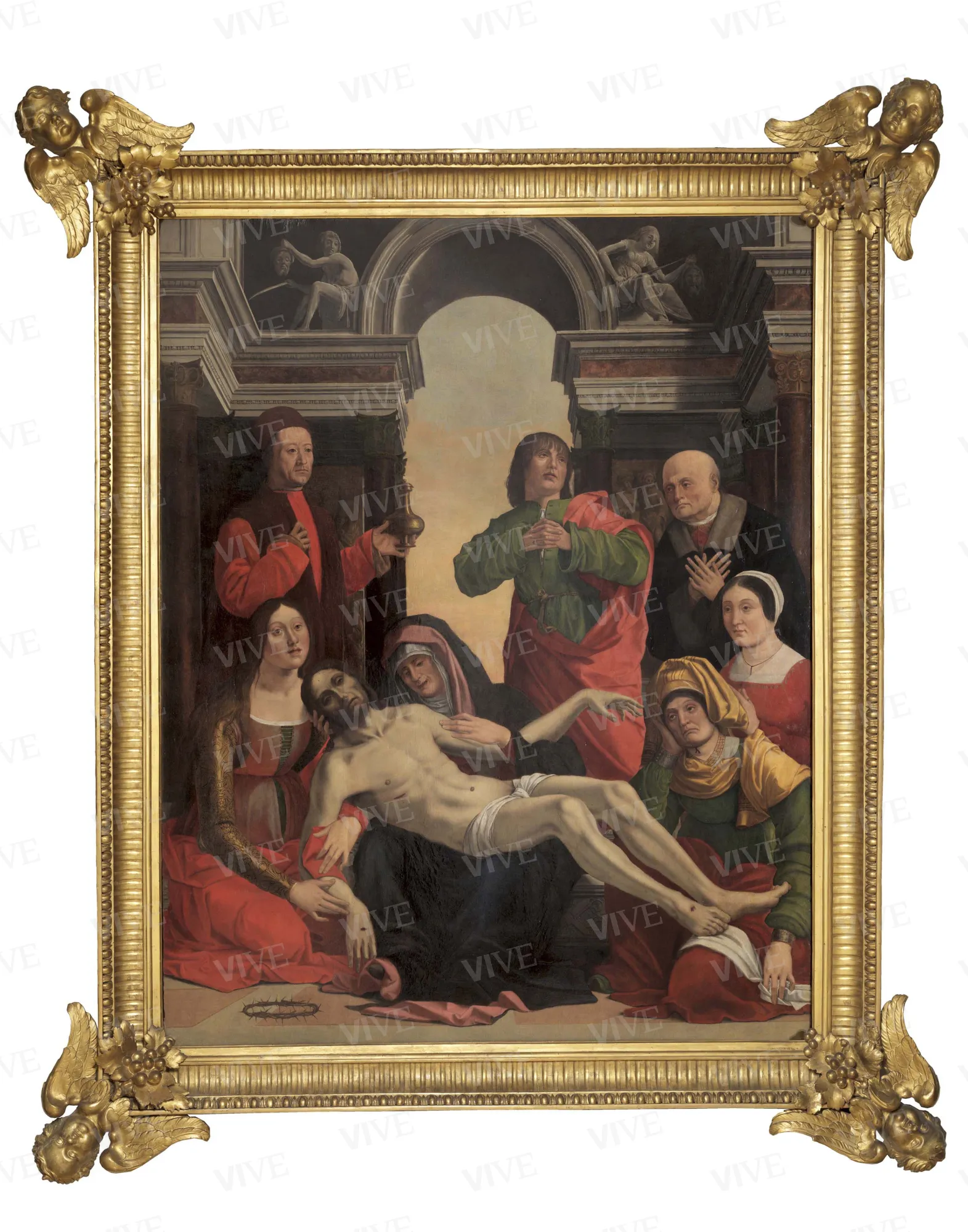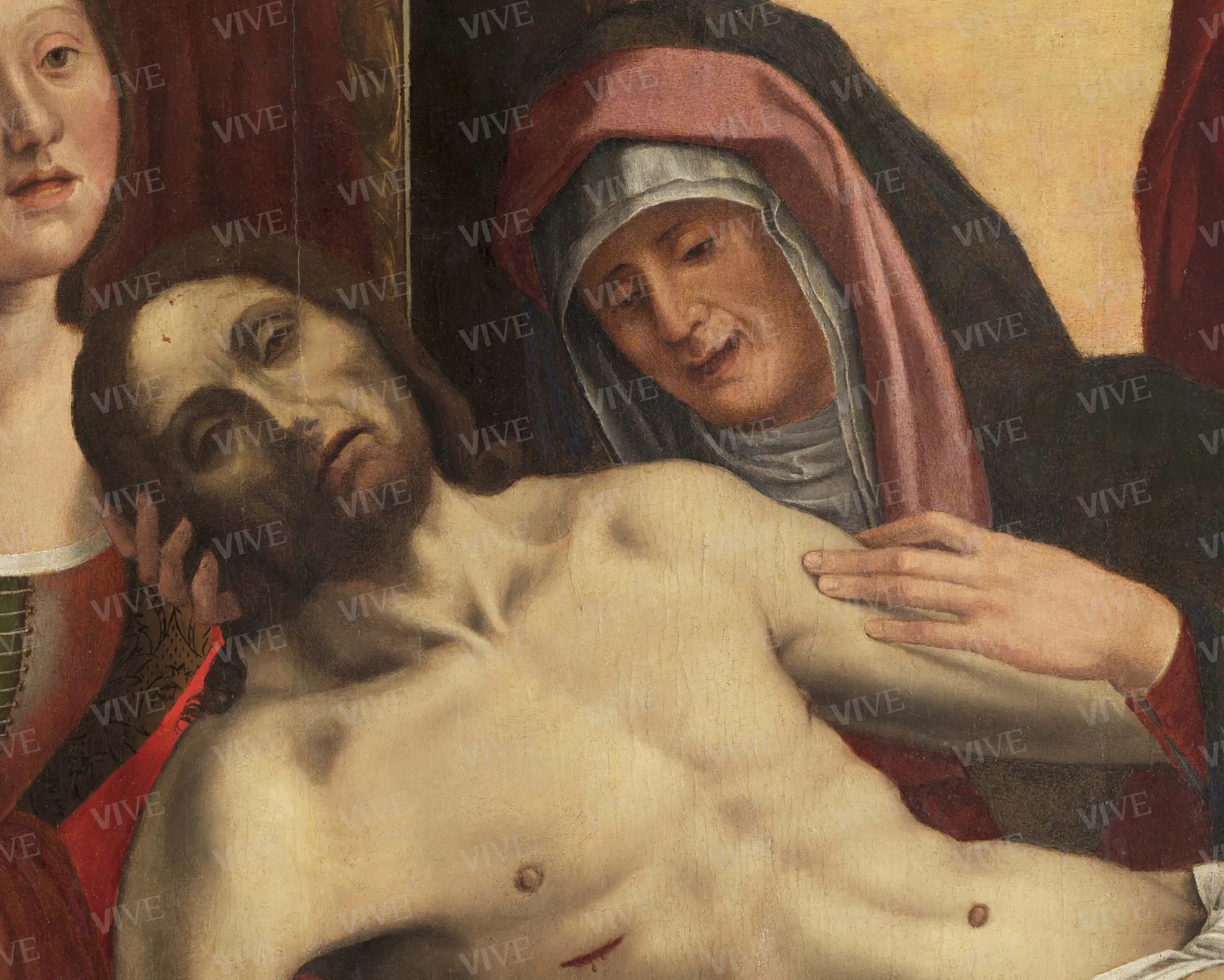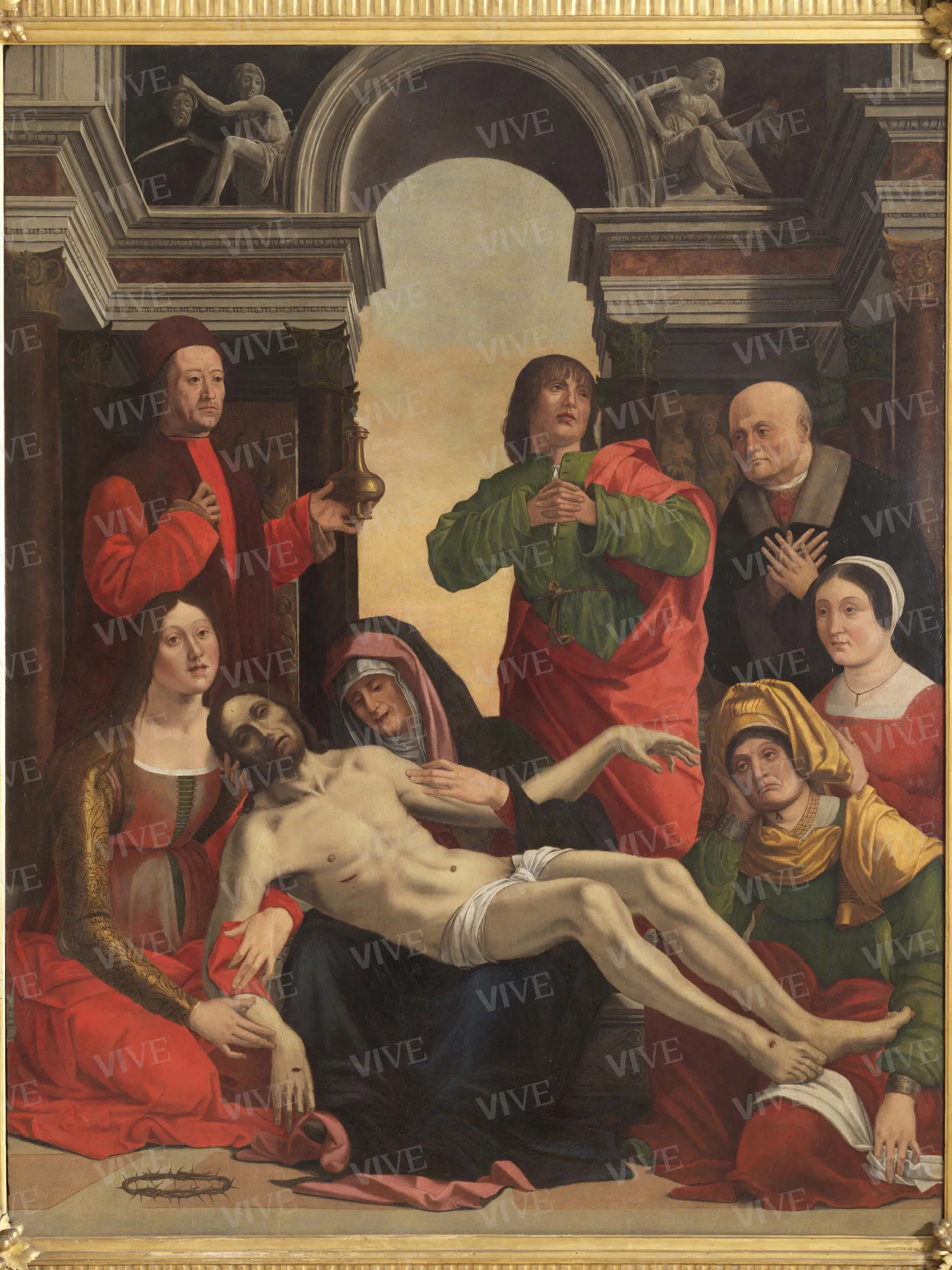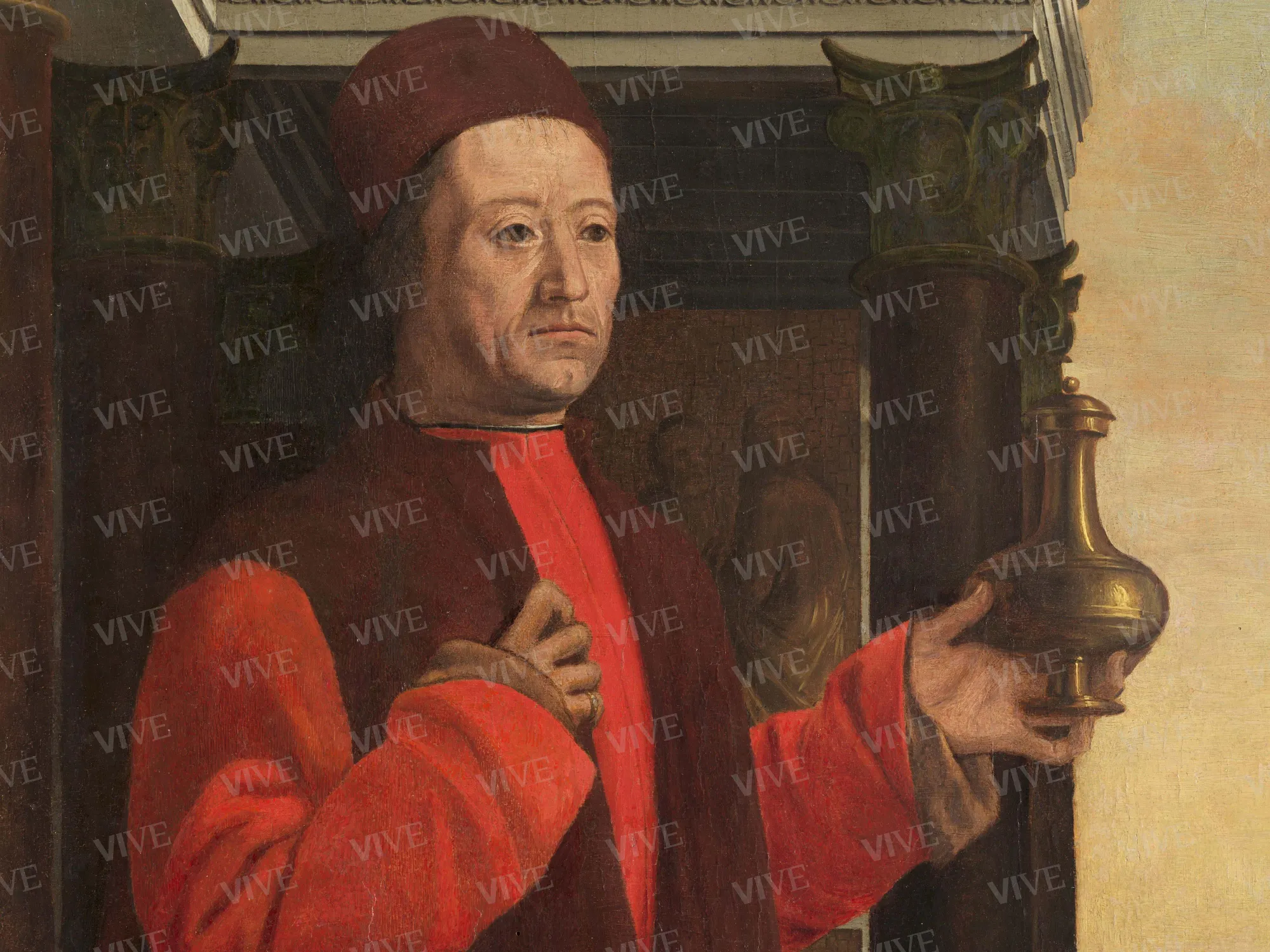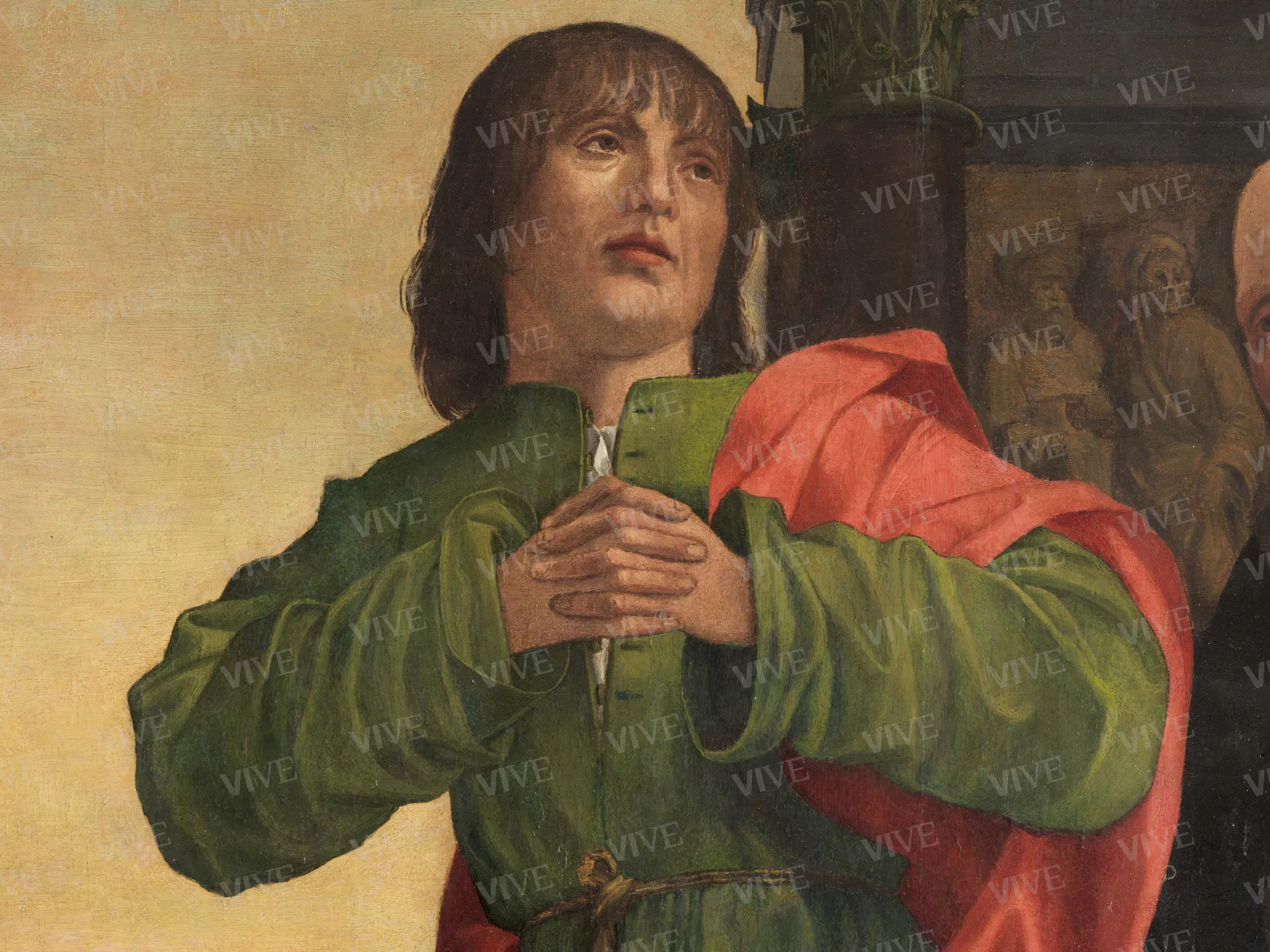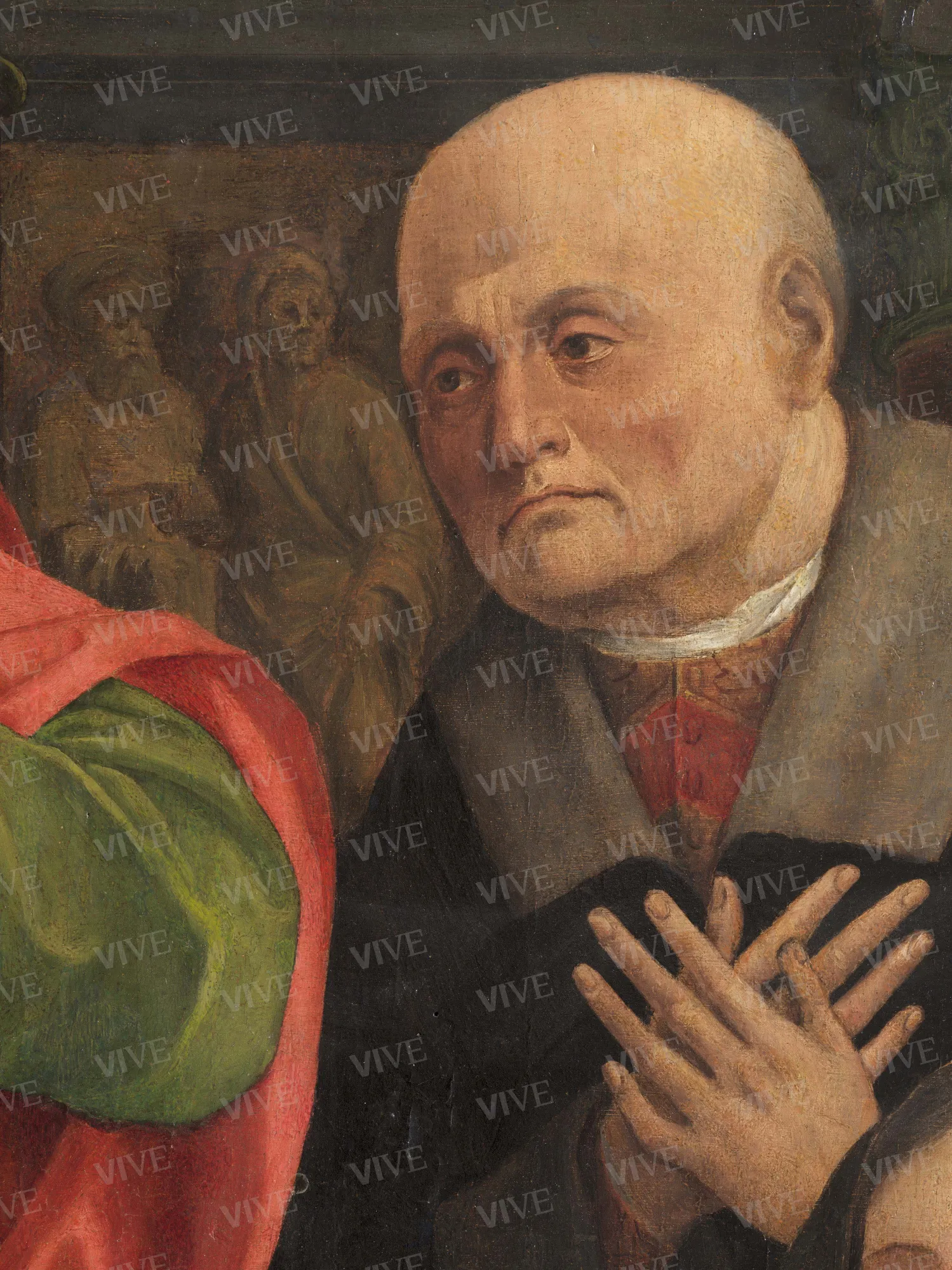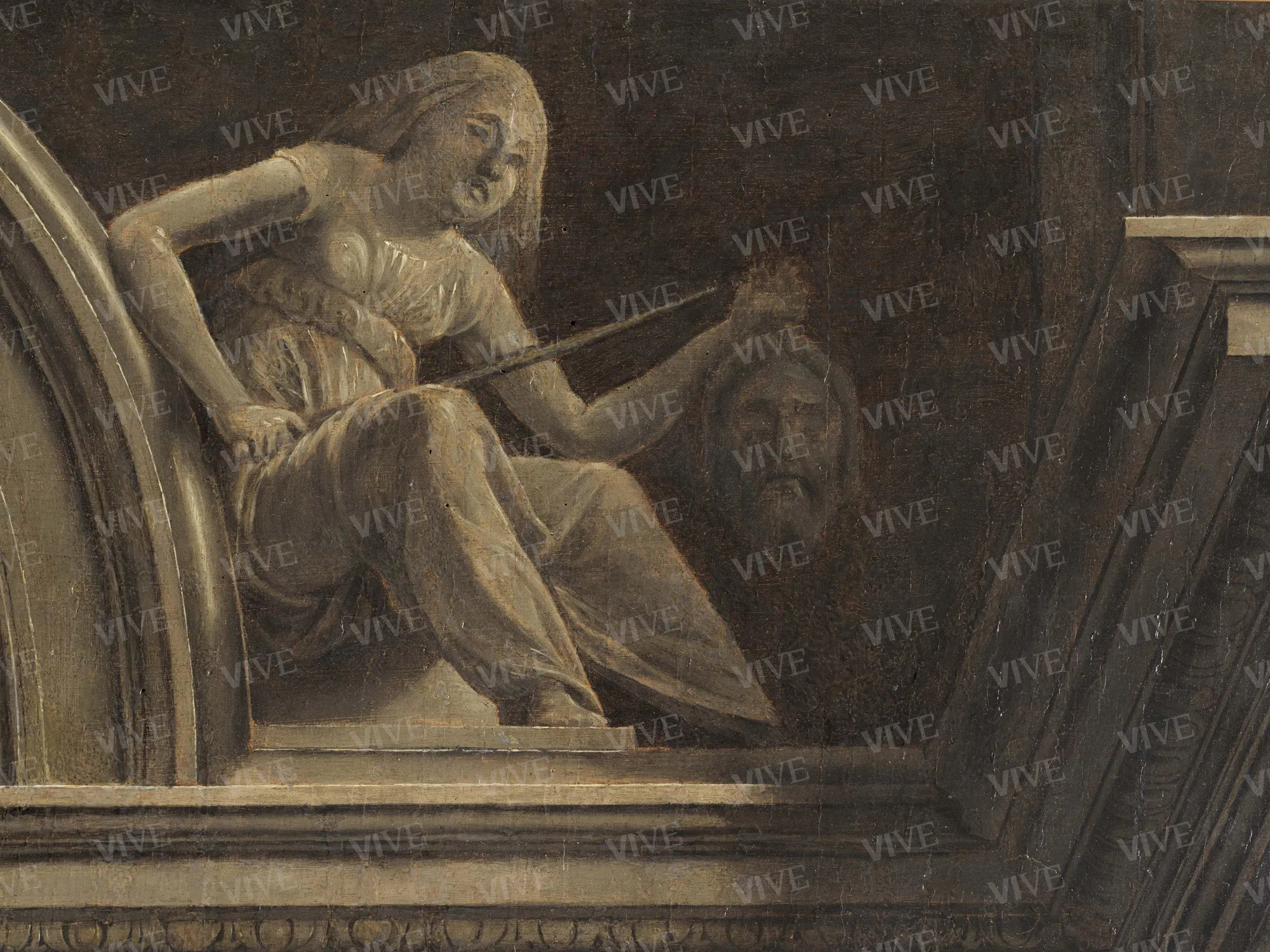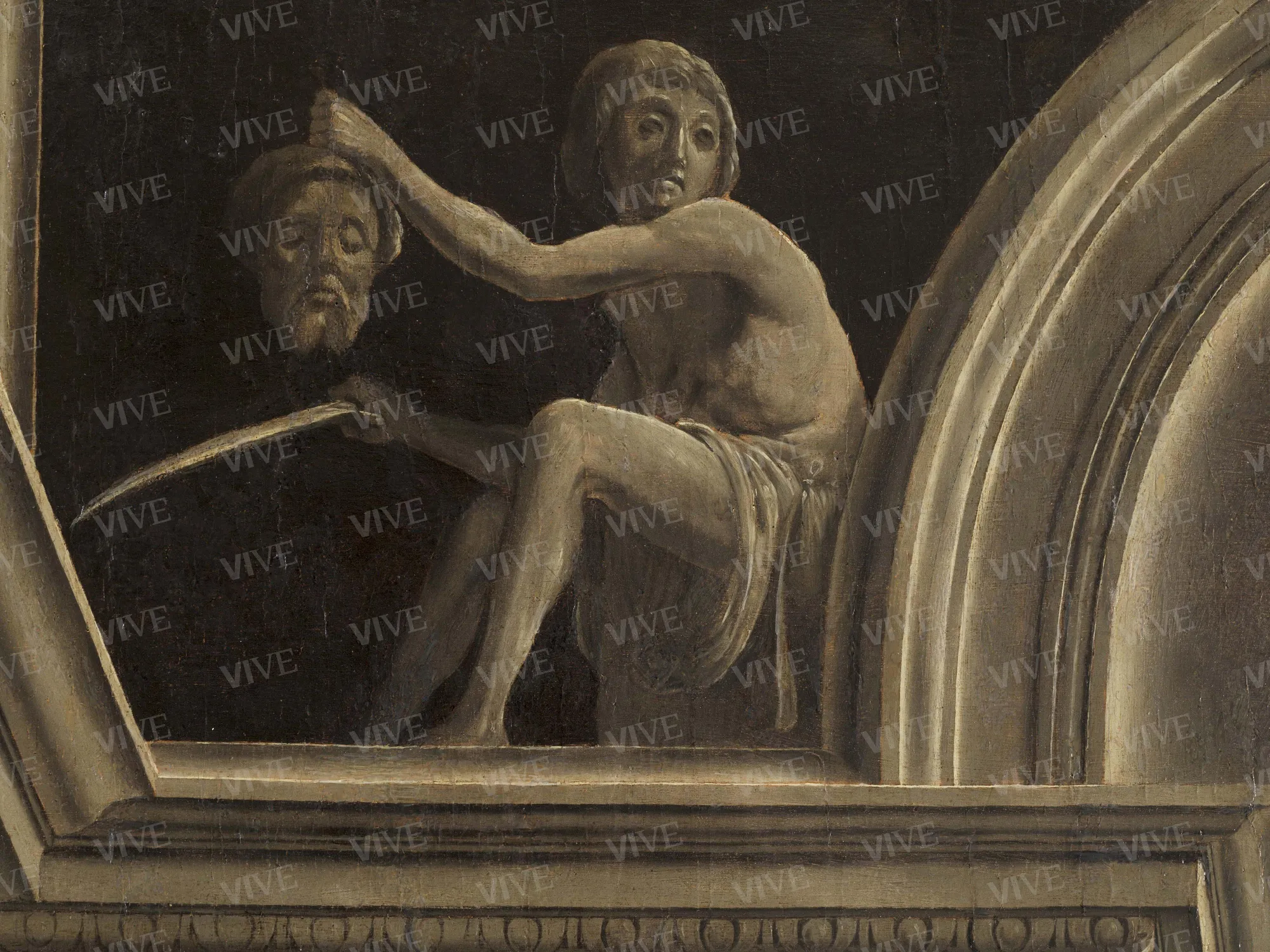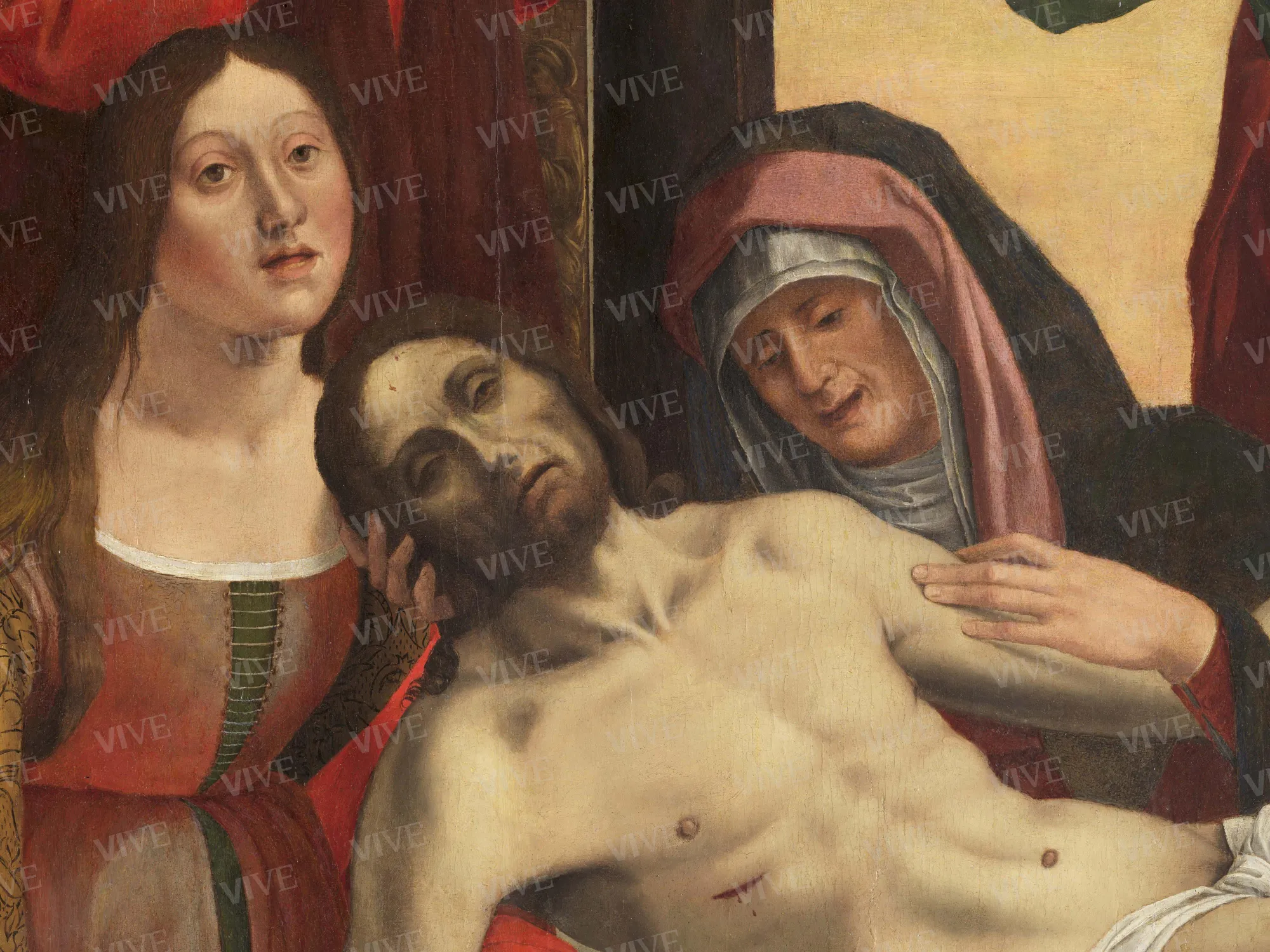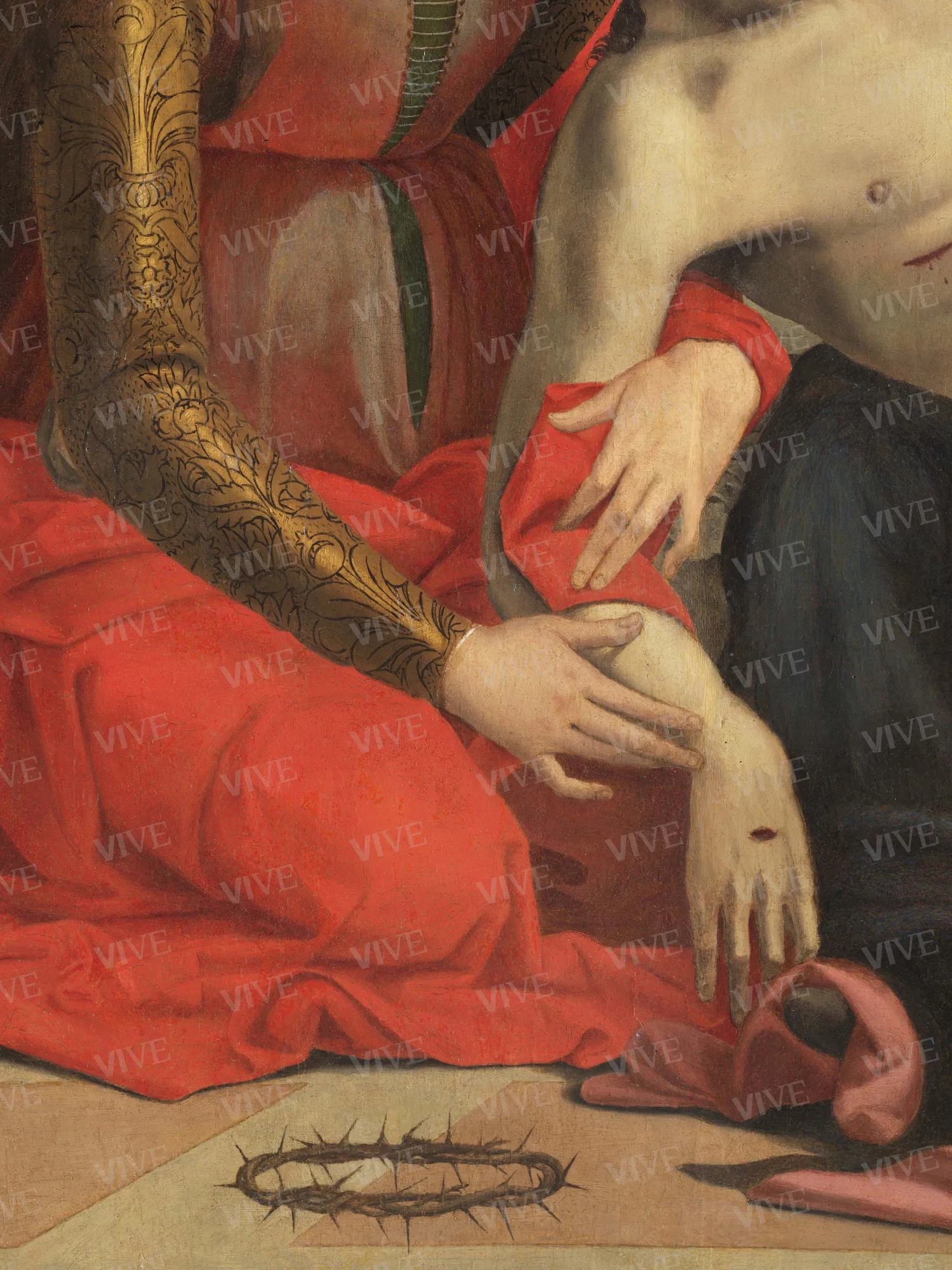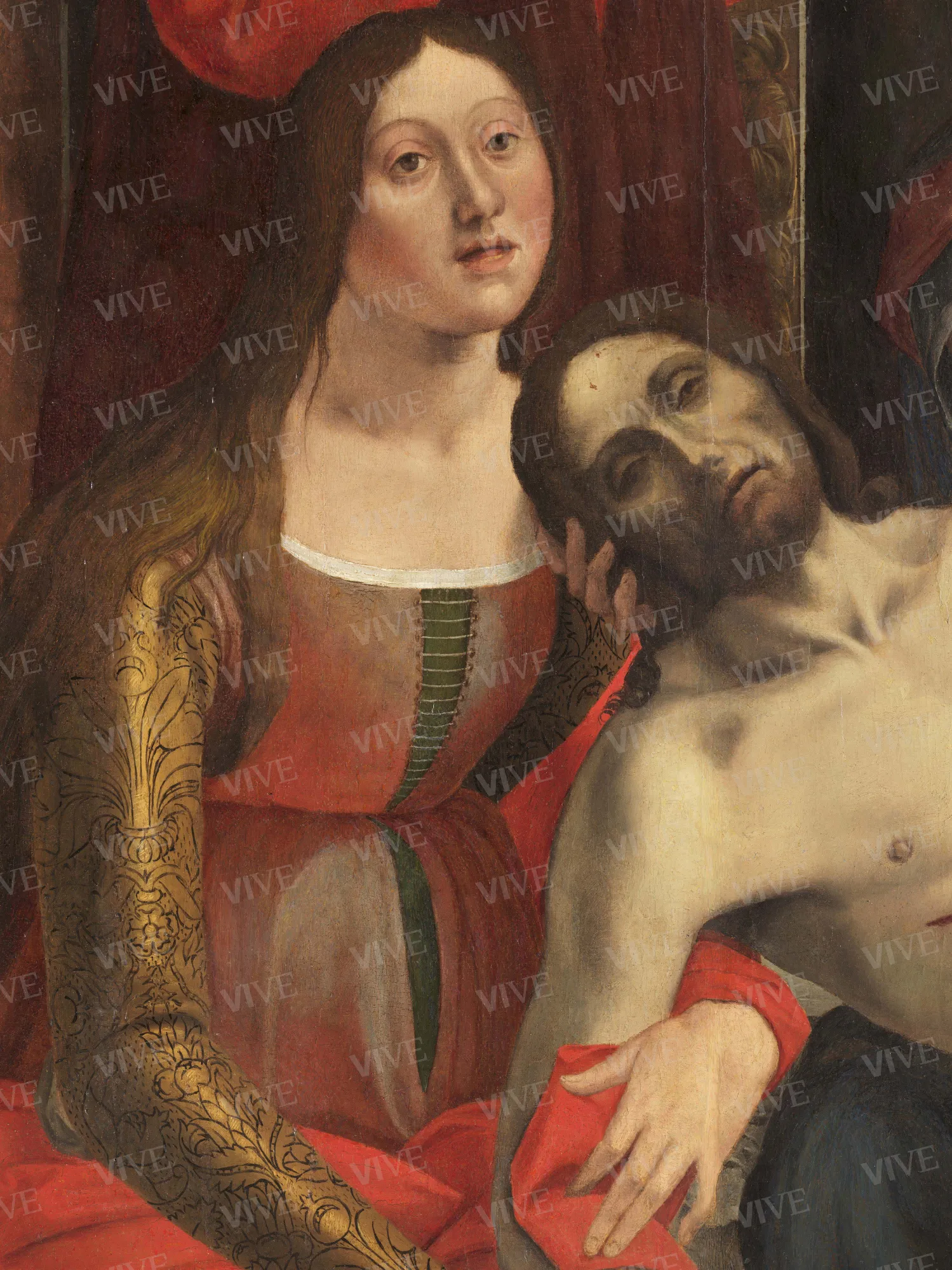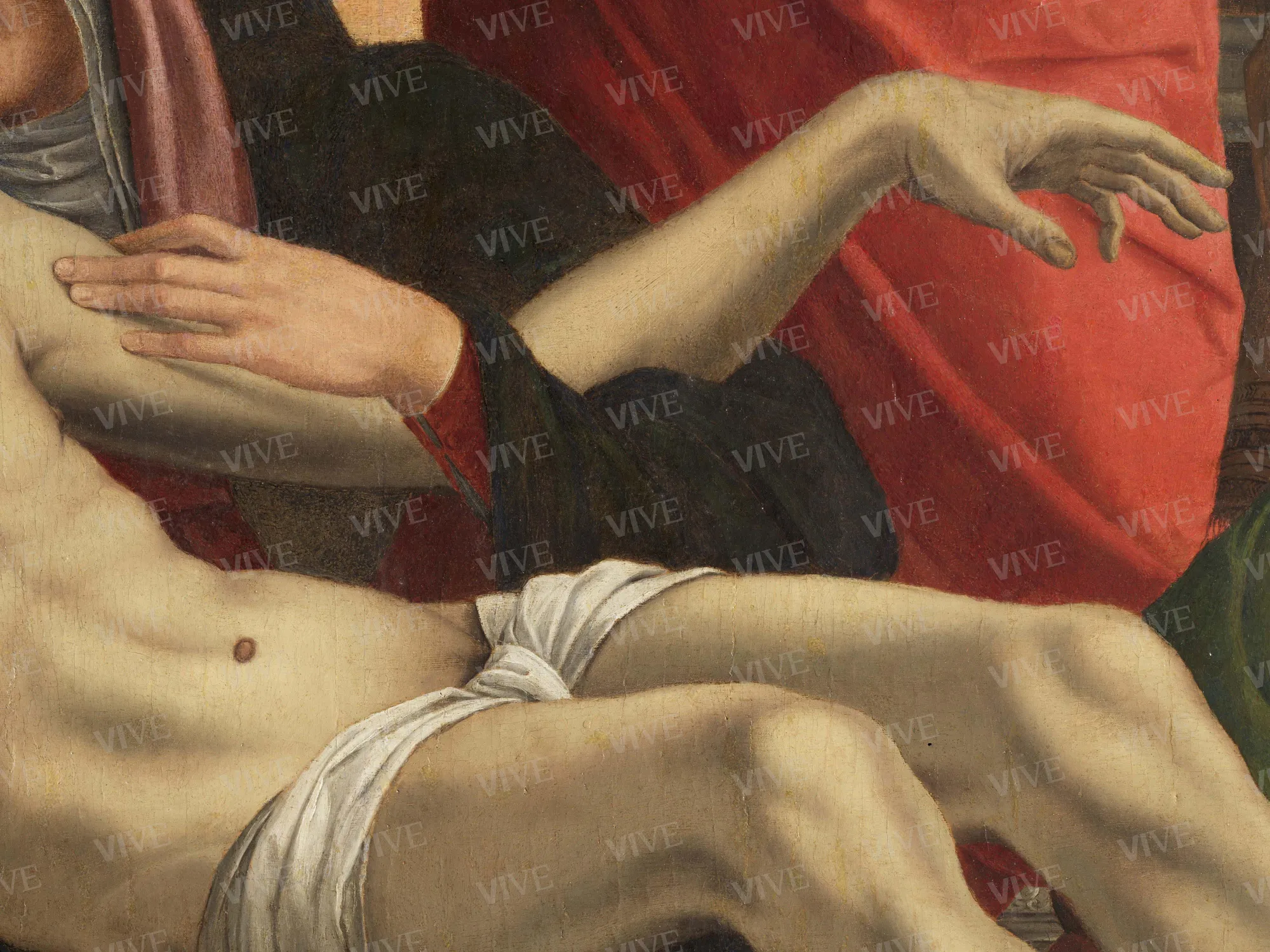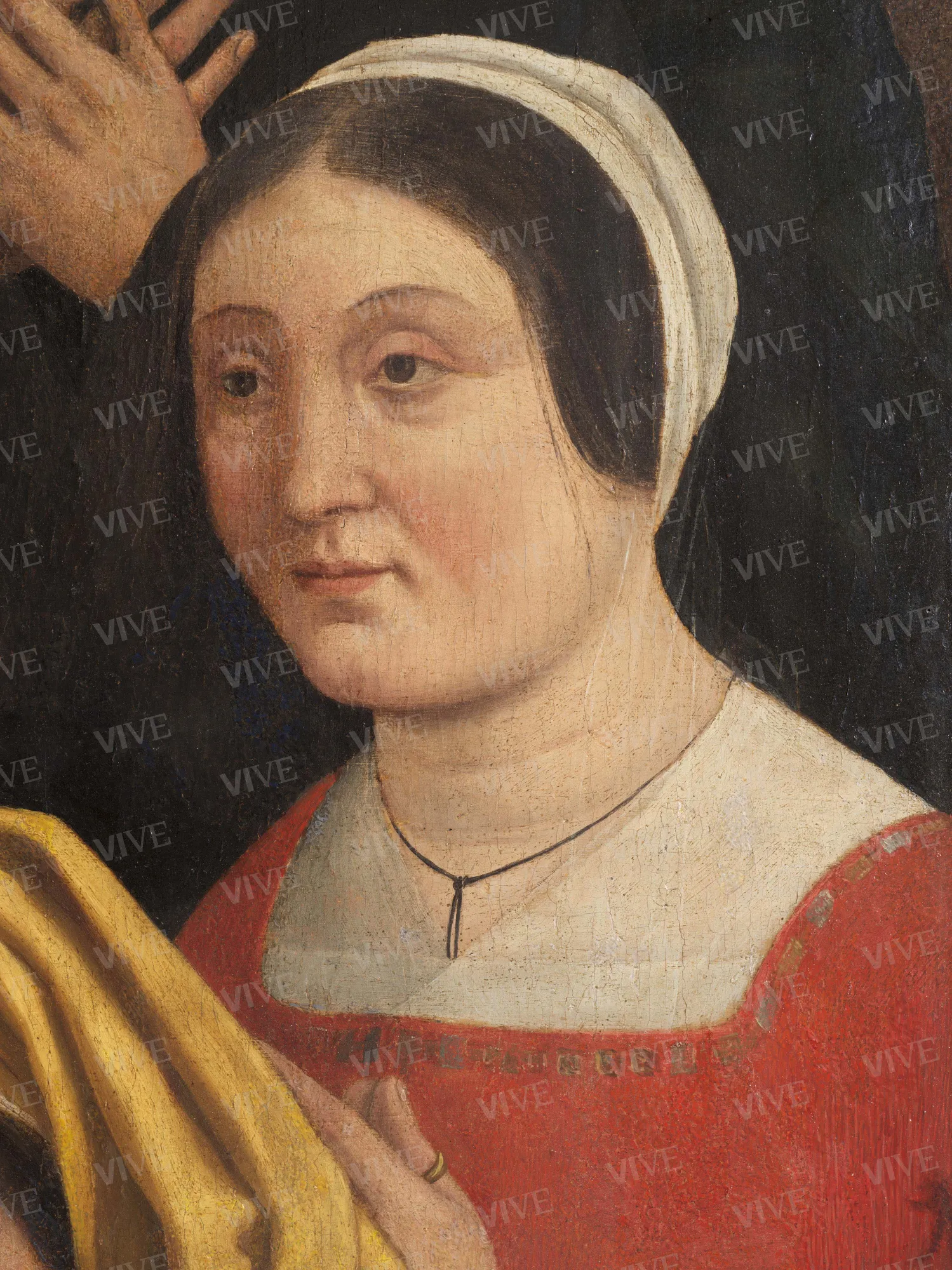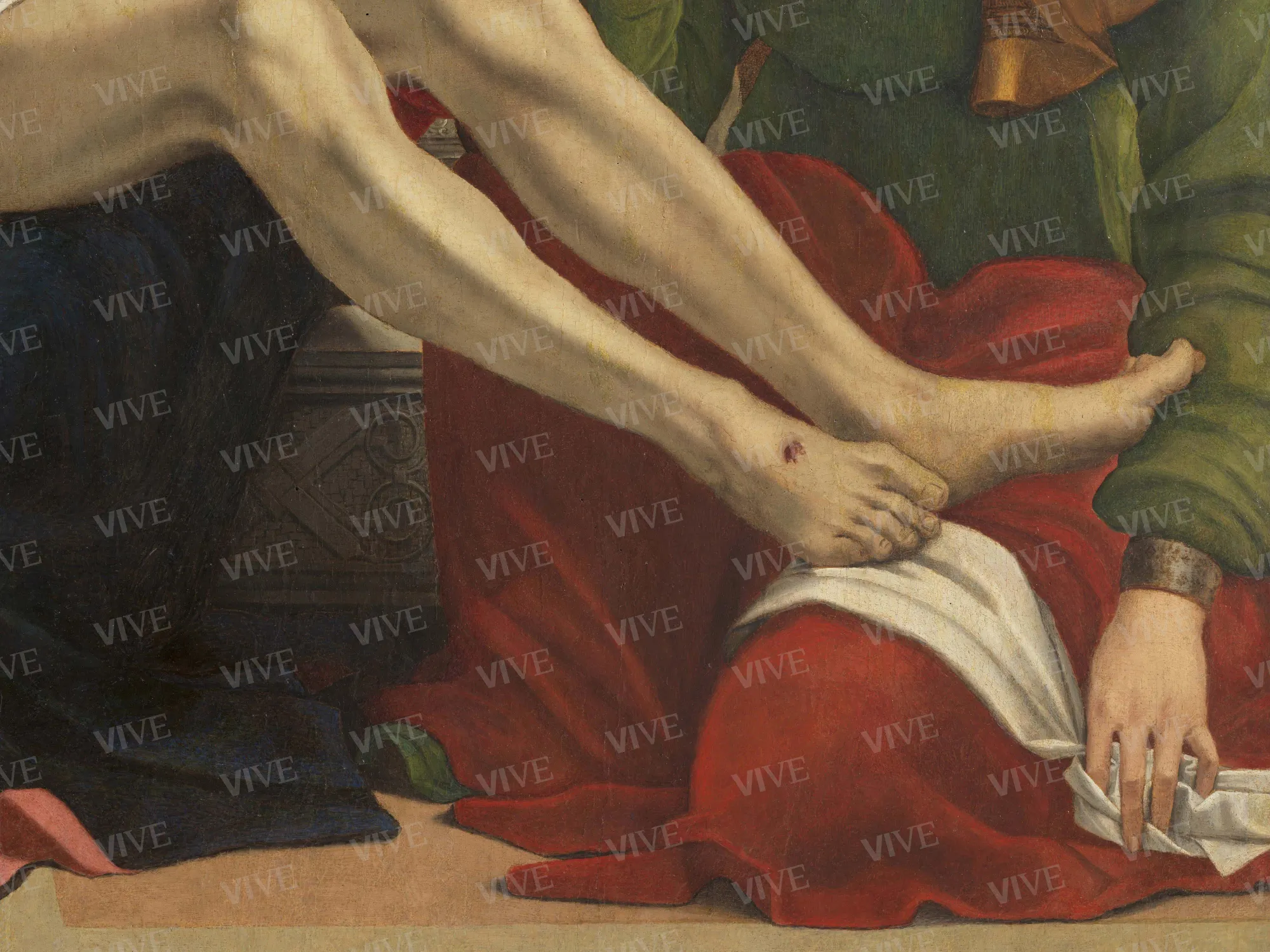Lamentation over the Dead Christ
Giovanni Francesco Maineri 1490-1498
The Lamentation over the Dead Christ was created for the church of San Domenico in Ferrara. Initially attributed to Ercole de’ Roberti, the altarpiece has since been associated with the early period of Giovanni Francesco Maineri, a painter and miniaturist from Parma who was active between the late fifteenth and early sixteenth century and was one of de’ Roberti’s notable collaborators.
The Lamentation over the Dead Christ was created for the church of San Domenico in Ferrara. Initially attributed to Ercole de’ Roberti, the altarpiece has since been associated with the early period of Giovanni Francesco Maineri, a painter and miniaturist from Parma who was active between the late fifteenth and early sixteenth century and was one of de’ Roberti’s notable collaborators.
Details of work
Catalog entry
The scene depicts a mourning over the dead Christ framed by painted architecture, including an arch supported by a high entablature, decorated with polychrome marble, and columns with gilded capitals. The lifeless body of Christ rests on his mother’s knees, flanked by Mary Magdalene, a woman on the right, and Saint John the Evangelist. Two figures and a male figure holding a cruet, possibly containing the oil for anointing Christ's body, are present. The style of fifteenth-century clothing and the individual features of these figures suggest that they may be portraits of the commissioners of the panel.
Above, on either side of the painted arch, are reliefs depicting David and Goliath and Judith and Holofernes. Below these reliefs, behind the sacred story, are several monochrome painted historiated panels.
This artwork originates from the Church of San Domenico in Ferrara, where Guarini (1621, pp. 89, 383) noted “a dead Christ and other figures to the right of the Altar Maggiore, by Hercole del Grandi.” It was subsequently transported to Rome during the devolution of Ferrara to the Papal States in 1598.
Baruffaldi noted that between the late seventeenth and early eighteenth centuries, a copy of an altarpiece “depicting Jesus Christ dead on his Mother’s lap with the Marys and St. John,” by “Ercole Grandi,” was displayed in the San Domenico cloister (Baruffaldi 1844–1846, I, pp. 139–140). He also mentioned a larger panel in the college of the Society of Jesus showing Jesus Christ deposed from the cross with the Virgin Mary, St. Catherine martyr, and other saints, identified as the Deposition of Christ attributed to Giuseppe Mazzuoli (Bastarolo) in the Pinacoteca Nazionale, Ferrara. This piece might have originated from the same cartoon as the Lamentation but served as a counterpart (Faietti 1992).
Andrea Bacchi (1990, p. 39, note 3) has proposed identifying the original altarpiece that was already in the Ferrara church with the panel currently housed in the Palazzo Venezia Museum. Furthermore, he suggests that the copy from the cloister of San Domenico can be recognized in the three canvas fragments that belonged to Giuseppe Boschini in the mid-nineteenth century. These fragments include the “Magdalene prostrate at the feet of Jesus,” “Joseph of Arimathea standing, holding the shroud, and looking at a devout person, whose clasped hands are all that remain,” and finally “a highly detailed landscape, significantly deteriorated, which was located in the upper part of the painting.“
Boschini (as cited in the notes to Baruffaldi, 1844–1846, I, pp. 139–140, footnote 1, II, p. 524) identified the San Domenico altarpiece in the artwork acquired by Cesare Favalli in Ferrara between 1710 and 1726. This suggests that the Lamentation housed in Palazzo Venezia had returned to Emilia by the early eighteenth century. It later made its way back to Rome in the early nineteenth century through Count Nicola Zeloni, eventually becoming part of the Blumenstihl collection.
The traditional attribution of the work to Ercole de’ Roberti, erroneously distinguished from Ercole Grandi, who was recognized as a painter of sixteenth-century culture, was questioned by several scholars. Fritz Harck (1884), Francesco Filippini (1917, p. 56), who considered it to be a late-sixteenth-century copy, and Adolfo Venturi (1931, p. 50), who more accurately suggested a painter similar to Ercole de’ Roberti, all cast doubt on this attribution. Since then, critics have been divided, with some identifying it as an original by Ercole de’ Roberti (Gamba 1933; Mauceri 1933; Gronau 1934; Salmi 1960; Molajoli 1974) and others considering it to be a copy (Bargellesi 1934; Ortolani 1941; Nicolson 1950; Diana 1985; Turrill 1986; Manca 1992; Syson 1999).
Joseph Manca (1985; 1992) proposed that the altarpiece was commissioned from de’ Roberti, who subsequently executed the presumed predella. According to Manca, this predella can be identified in the panels depicting the Gathering of Manna, Abraham and Melchizedek, and The Last Supper, which Federico Zeri (1965) attributed to the Ferrara painter.
Andrea Bacchi (1990), dismissing the notion that the panel is a copy, attributed the Lamentation to the early period of Giovanni Francesco Maineri, a painter and miniaturist from Parma (documented between 1489 and 1506), to whom the altarpiece is currently ascribed. Building on the hypotheses proposed by Manca and Bacchi, Monica Molteni (1995) acknowledged the possibility that the commission was initially given to Ercole, who completed the presumed predella, before being given to Maineri.
This work engages with the legacy of Ercole de’ Roberti, as collected by Maineri, who received his training in the workshop of Ferrara’s most renowned painter. The Lamentation should be contextualized alongside the execution of the Madonna and Child (formerly Milan, Collezione Canto) and Brutus, Collatinus, and Lucretia (Modena, Galleria Estense), which were created by Maineri in Ercole’s workshop (De Marchi 1992, p. 1069). This period precedes Maineri’s time in Mantua, where he arrived in November 1498 to portray Isabella d’Este, and where his reputation as a portrait painter had already become well established (Pattanaro 1995, p. 112).
Cristina Conti
Entry published on 27 March 2025
State of conservation
Good.
Restorations and analyses
2002: restoration by Annamaria Brignardello in the Palazzo Barberini workshop;
2014: restoration by Carlo Giantomassi and Donatella Zari with the collaboration of Marco Pulieri and Paola Zari, under the supervision of Andreina Draghi.
Inscriptions
An inscription on paper attached to the back of the panel reads: “I declare that the lord prince / of Sulmona has permitted me to exhibit / for only eight days in his gallery / my painting by Ercole Grandi representing / the Deposition of the Cross, with the obligation to retrieve it / at my own expense on the 26th of this month / In faith this day of December 19th, 1873 / Count Alessandro (?) Zeloni”;
some scholars have noted the presence of an inscription—“E. GRANDI F. MDXXXIIII”—on the sarcophagus at the bottom (Morelli 1880; Manca 1992) or on the back (Turrill 1986; Molteni 1995; Syson 1999), which is no longer visible
Provenance
Ferrara, Church of San Domenico;
Rome, transported in 1598;
Ferrara, purchased by Cesare Favalli between 1710 and 1726;
Ferrara, collection of Cesare Paris;
Ferrara, collection of Cesare Cittadella, after 1784;
Bologna, collection of the Ferrara physician Antonio Testa;
Rome, collection of Count Nicola Zeloni, after 1814; in December 1873, the panel was the property of Count Alessandro Zeloni and was exhibited for eight days at the Galleria Borghese at the behest of Marcantonio V Borghese, Prince of Sulmona; the day after Count Zeloni’s death (December 1882) it was among the possessions pledged to the Monte di Pietà where it was purchased by Count Blumenstihl, whose heirs deposited it in the Galleria Spada. Since the end of the 1880s, the altarpiece has been kept in the storage rooms of Palazzo Venezia.
Exhibition history
Ferrara, Palazzo dei Diamanti, Rinascimento a Ferrara. Ercole de’ Roberti e Lorenzo Costa, February 18–June 19 2023.
Sources and documents
Guarini Marco Antonio, Compendio Historico dell'Origine, Accrescimento e Prerogative delle Chiese e Luoghi Pii della Città e Diocesi di Ferrara, Ferrara 1621, pp. 89, 383;
Cittadella C., Catalogo istorico de’ pittori e scultori ferraresi, Ferrara 1782–1783, I, p. 115.
References
Baruffaldi Girolamo, Vite de’ pittori e scultori ferraresi [1697/1702-1722], 2 voll., Ferrara 1844-1846, I, pp. 139-140, 464, II p. 524;
Laderchi Camillo, La pittura ferrarese: memorie, Ferrara 1856, p. 53;
Morelli Giovanni, Die Werke italienischer Meister in den Galerien von Münche, Dresden und Berlin: ein kritische Versuch, Leipzig 1880, pp. 134-135;
Harck Fritz, Die Fresken im Palazzo Schifanoja in Ferrara, in «Jahrbuch der Preußischen Kunstsammlungen», 5, 1884, pp. 99-127;
Filippini Francesco, Ercole da Ferrara ed Ercole da Bologna, in «Bollettino d’arte del Ministero della Pubblica Istruzione», 11, 1917, pp. 33-34;
Venturi Adolfo, La pittura del ’400 in Emilia, Verona 1931, p. 50;
Gamba Carlo, Ercole da Ferrara, Ferrara 1933, p. 13;
Mauceri Enrico, Ercole de’ Roberti e la “Deposizione” della R. Pinacoteca di Bologna, in «Bollettino d’arte», 3, 26, 1932-1933, pp. 482-487;
Bargellesi Giacomo, Ercole da Ferrara, in «Rivista di Ferrara», 9, 1934, pp. 13-14;
Gronau George, ad vocem, Ercole de’ Roberti, in «Allgemeines Lexikon der bildenden Kunstler, XXVIII, 1934, pp. 426-427;
Ortolani Sergio, Cosmè Tura, Francesco del Cossa, Ercole de’ Roberti, Milano 1941, pp. 180-181;
Nicolson Benedict, The Painters of Ferrara, London 1950, p. 20;
Salmi Mario, Ercole de’ Roberti, Milano 1960, p. 41;
Zeri Federico, Appunti per Ercole de’ Roberti, in «Bollettino d’arte», 50, 1965, pp. 72-79;
Molajoli Rosemari, L’opera completa di Cosmè Tura e i grandi pittori ferraresi del suo tempo: Francesco Cossa e Ercole de’ Roberti, Milano 1974, p. 98, n. 118;
Diana Maria Grazia, Giuseppe Mazzuoli detto il Bastarolo, “Deposizione di Cristo dalla Croce”, in Bentini Jadranka (a cura di), San Giorgio e la Principessa di Cosmè Tura. Dipinti restaurati per l’officina ferrarese, Bologna 1985, pp. 209-215;
Manca Joseph, An Altar-piece by Ercole de’ Roberti Reconstructed, in «The Burlington Magazine», 127, 1985, pp. 521-522;
Turrill Catherine, Ercole de’ Roberti’s Altarpieces for the Lateran Canons, Ph.D Diss., University of Delawere, Ann Arbor Michigan, 1986, pp. 355-364, L-10;
Bacchi Andrea, Dipinti ferraresi dalla collezione Vittorio Cini, Vicenza 1990, pp. 38-40, 42, fig. 6c;
Faietti, in Bentini Jadranka (a cura di), La Pinacoteca Nazionale di Ferrara, Bologna 1992, pp. 181-182, n. 214;
De Marchi Andrea, Un geniale anacronista, nel solco di Ercole, in «Annali della Scuola Normale Superiore di Pisa», 3, 22, 1992, pp. 1039-1071: 1068-1069;
Manca Joseph, The Art of Ercole de’ Roberti, Cambridge, Cambridge University Press, 1992, pp. 147-150, cat. 24a;
Molteni Monica, Ercole de’ Roberti, Milano 1995, pp. 204-205, cat. 70;
Pattanaro Alessandra, Regesto della pittura a Ferrara (1497-1548), in Ballarin Alessandro (a cura di), Dosso Dossi. La pittura a Ferrara negli anni del ducato di Alfonso I, I, Cittadella 1995, pp. 111-179;
Syson Luke, Ercole de’ Roberti: the Making of a Court Artist, in Allen Denise, Syson L. (a cura di), Ercole de’ Roberti. The Renaissance in Ferrara, in «The Burlington Magazine», 141, 1999, 1153, pp. V-XIV;
Danieli Michele, Di Natale Pietro, Sgarbi Vittorio (a cura di), Rinascimento a Ferrara. Ercole de’ Roberti e Lorenzo Costa, catalogo della mostra (Ferrara, Palazzo dei Diamanti, 18 febbraio-19 giugno 2023), Cinisello Balsamo 2023, p. 259, cat. n. 61, fig. p. 249.

